Strategic Analysis Report: Assignment
VerifiedAdded on 2021/06/05
|20
|4756
|466
AI Summary
Contribute Materials
Your contribution can guide someone’s learning journey. Share your
documents today.
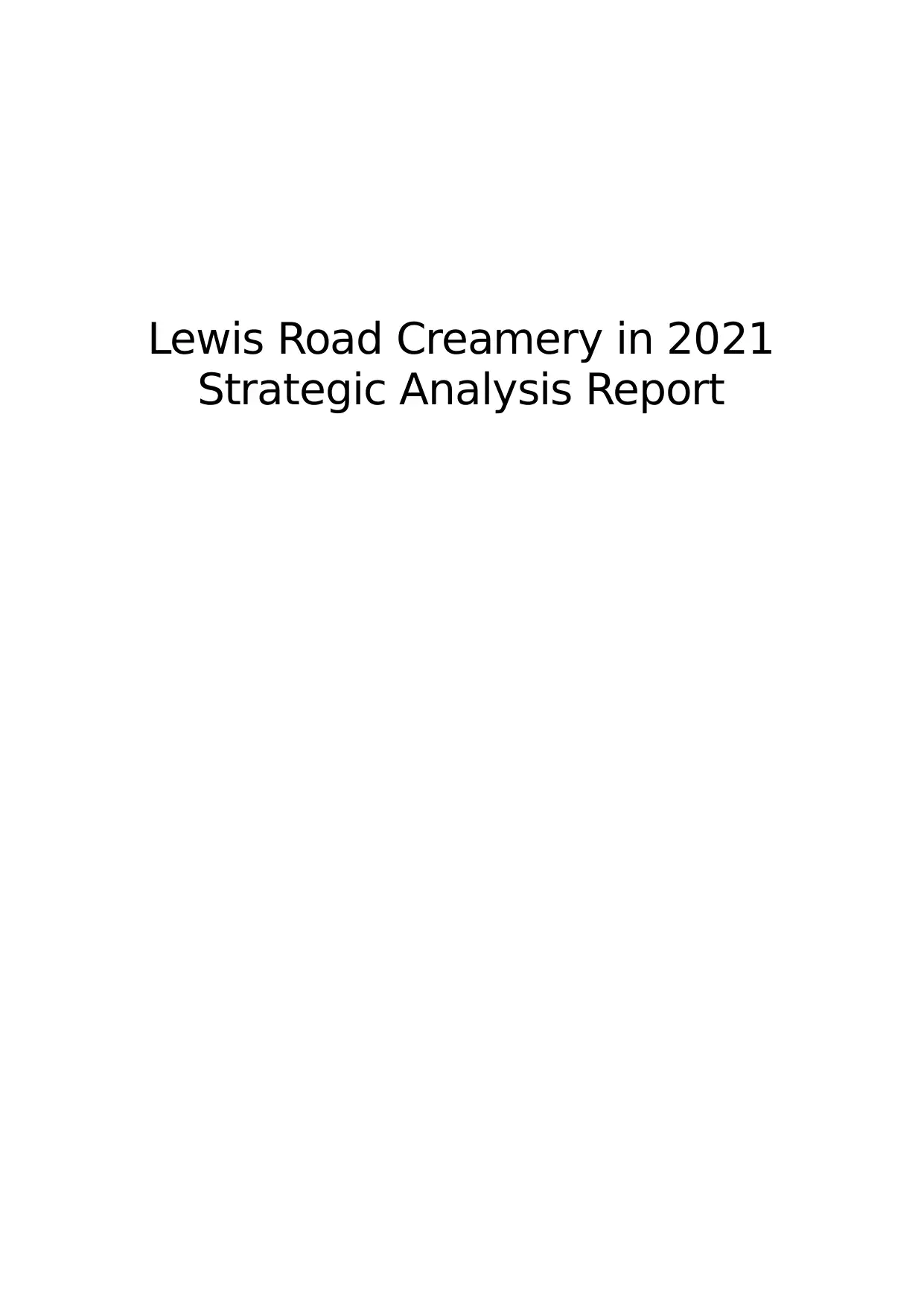
Lewis Road Creamery in 2021
Strategic Analysis Report
Strategic Analysis Report
Secure Best Marks with AI Grader
Need help grading? Try our AI Grader for instant feedback on your assignments.
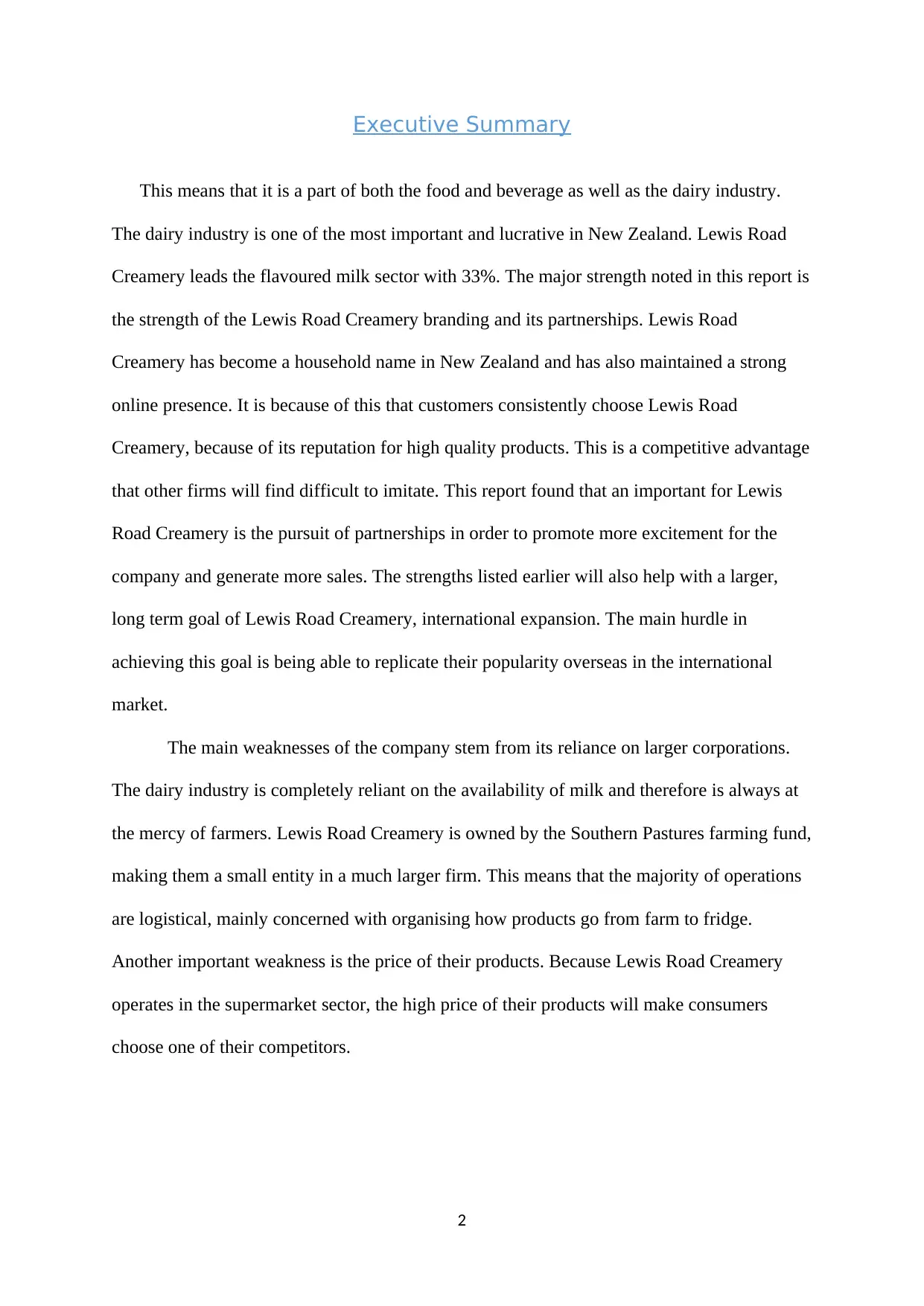
Executive Summary
This means that it is a part of both the food and beverage as well as the dairy industry.
The dairy industry is one of the most important and lucrative in New Zealand. Lewis Road
Creamery leads the flavoured milk sector with 33%. The major strength noted in this report is
the strength of the Lewis Road Creamery branding and its partnerships. Lewis Road
Creamery has become a household name in New Zealand and has also maintained a strong
online presence. It is because of this that customers consistently choose Lewis Road
Creamery, because of its reputation for high quality products. This is a competitive advantage
that other firms will find difficult to imitate. This report found that an important for Lewis
Road Creamery is the pursuit of partnerships in order to promote more excitement for the
company and generate more sales. The strengths listed earlier will also help with a larger,
long term goal of Lewis Road Creamery, international expansion. The main hurdle in
achieving this goal is being able to replicate their popularity overseas in the international
market.
The main weaknesses of the company stem from its reliance on larger corporations.
The dairy industry is completely reliant on the availability of milk and therefore is always at
the mercy of farmers. Lewis Road Creamery is owned by the Southern Pastures farming fund,
making them a small entity in a much larger firm. This means that the majority of operations
are logistical, mainly concerned with organising how products go from farm to fridge.
Another important weakness is the price of their products. Because Lewis Road Creamery
operates in the supermarket sector, the high price of their products will make consumers
choose one of their competitors.
2
This means that it is a part of both the food and beverage as well as the dairy industry.
The dairy industry is one of the most important and lucrative in New Zealand. Lewis Road
Creamery leads the flavoured milk sector with 33%. The major strength noted in this report is
the strength of the Lewis Road Creamery branding and its partnerships. Lewis Road
Creamery has become a household name in New Zealand and has also maintained a strong
online presence. It is because of this that customers consistently choose Lewis Road
Creamery, because of its reputation for high quality products. This is a competitive advantage
that other firms will find difficult to imitate. This report found that an important for Lewis
Road Creamery is the pursuit of partnerships in order to promote more excitement for the
company and generate more sales. The strengths listed earlier will also help with a larger,
long term goal of Lewis Road Creamery, international expansion. The main hurdle in
achieving this goal is being able to replicate their popularity overseas in the international
market.
The main weaknesses of the company stem from its reliance on larger corporations.
The dairy industry is completely reliant on the availability of milk and therefore is always at
the mercy of farmers. Lewis Road Creamery is owned by the Southern Pastures farming fund,
making them a small entity in a much larger firm. This means that the majority of operations
are logistical, mainly concerned with organising how products go from farm to fridge.
Another important weakness is the price of their products. Because Lewis Road Creamery
operates in the supermarket sector, the high price of their products will make consumers
choose one of their competitors.
2
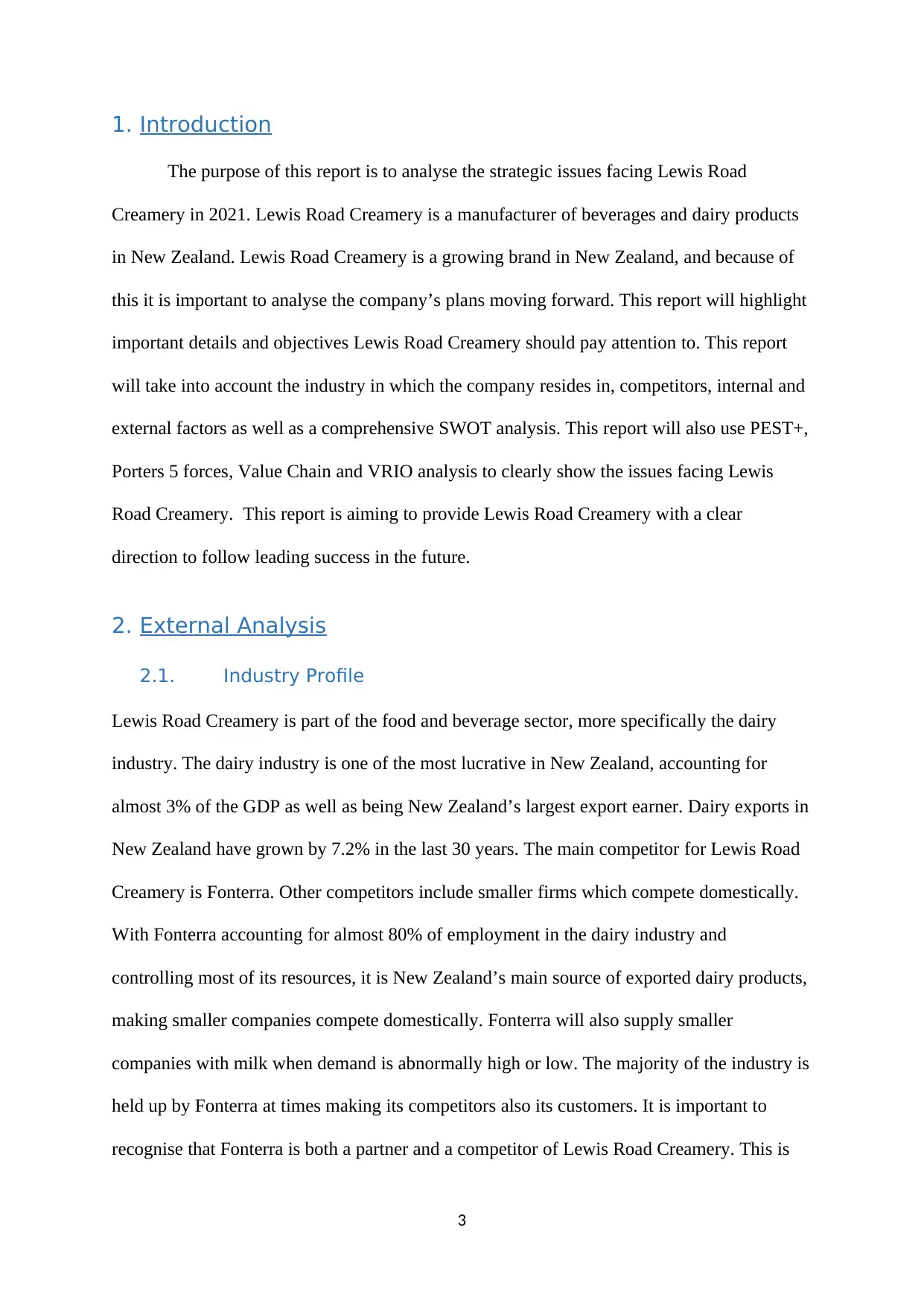
1. Introduction
The purpose of this report is to analyse the strategic issues facing Lewis Road
Creamery in 2021. Lewis Road Creamery is a manufacturer of beverages and dairy products
in New Zealand. Lewis Road Creamery is a growing brand in New Zealand, and because of
this it is important to analyse the company’s plans moving forward. This report will highlight
important details and objectives Lewis Road Creamery should pay attention to. This report
will take into account the industry in which the company resides in, competitors, internal and
external factors as well as a comprehensive SWOT analysis. This report will also use PEST+,
Porters 5 forces, Value Chain and VRIO analysis to clearly show the issues facing Lewis
Road Creamery. This report is aiming to provide Lewis Road Creamery with a clear
direction to follow leading success in the future.
2. External Analysis
2.1. Industry Profile
Lewis Road Creamery is part of the food and beverage sector, more specifically the dairy
industry. The dairy industry is one of the most lucrative in New Zealand, accounting for
almost 3% of the GDP as well as being New Zealand’s largest export earner. Dairy exports in
New Zealand have grown by 7.2% in the last 30 years. The main competitor for Lewis Road
Creamery is Fonterra. Other competitors include smaller firms which compete domestically.
With Fonterra accounting for almost 80% of employment in the dairy industry and
controlling most of its resources, it is New Zealand’s main source of exported dairy products,
making smaller companies compete domestically. Fonterra will also supply smaller
companies with milk when demand is abnormally high or low. The majority of the industry is
held up by Fonterra at times making its competitors also its customers. It is important to
recognise that Fonterra is both a partner and a competitor of Lewis Road Creamery. This is
3
The purpose of this report is to analyse the strategic issues facing Lewis Road
Creamery in 2021. Lewis Road Creamery is a manufacturer of beverages and dairy products
in New Zealand. Lewis Road Creamery is a growing brand in New Zealand, and because of
this it is important to analyse the company’s plans moving forward. This report will highlight
important details and objectives Lewis Road Creamery should pay attention to. This report
will take into account the industry in which the company resides in, competitors, internal and
external factors as well as a comprehensive SWOT analysis. This report will also use PEST+,
Porters 5 forces, Value Chain and VRIO analysis to clearly show the issues facing Lewis
Road Creamery. This report is aiming to provide Lewis Road Creamery with a clear
direction to follow leading success in the future.
2. External Analysis
2.1. Industry Profile
Lewis Road Creamery is part of the food and beverage sector, more specifically the dairy
industry. The dairy industry is one of the most lucrative in New Zealand, accounting for
almost 3% of the GDP as well as being New Zealand’s largest export earner. Dairy exports in
New Zealand have grown by 7.2% in the last 30 years. The main competitor for Lewis Road
Creamery is Fonterra. Other competitors include smaller firms which compete domestically.
With Fonterra accounting for almost 80% of employment in the dairy industry and
controlling most of its resources, it is New Zealand’s main source of exported dairy products,
making smaller companies compete domestically. Fonterra will also supply smaller
companies with milk when demand is abnormally high or low. The majority of the industry is
held up by Fonterra at times making its competitors also its customers. It is important to
recognise that Fonterra is both a partner and a competitor of Lewis Road Creamery. This is
3
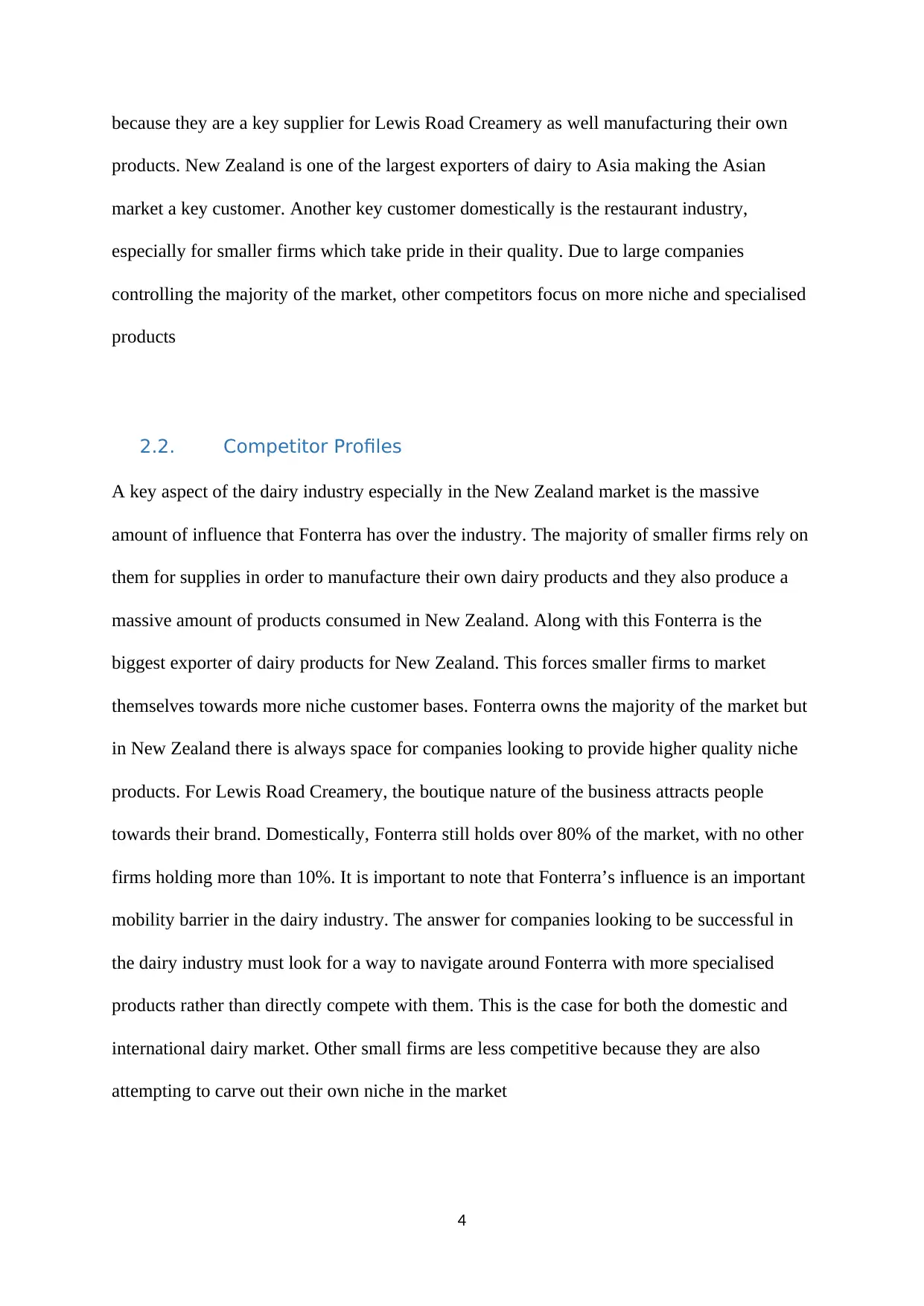
because they are a key supplier for Lewis Road Creamery as well manufacturing their own
products. New Zealand is one of the largest exporters of dairy to Asia making the Asian
market a key customer. Another key customer domestically is the restaurant industry,
especially for smaller firms which take pride in their quality. Due to large companies
controlling the majority of the market, other competitors focus on more niche and specialised
products
2.2. Competitor Profiles
A key aspect of the dairy industry especially in the New Zealand market is the massive
amount of influence that Fonterra has over the industry. The majority of smaller firms rely on
them for supplies in order to manufacture their own dairy products and they also produce a
massive amount of products consumed in New Zealand. Along with this Fonterra is the
biggest exporter of dairy products for New Zealand. This forces smaller firms to market
themselves towards more niche customer bases. Fonterra owns the majority of the market but
in New Zealand there is always space for companies looking to provide higher quality niche
products. For Lewis Road Creamery, the boutique nature of the business attracts people
towards their brand. Domestically, Fonterra still holds over 80% of the market, with no other
firms holding more than 10%. It is important to note that Fonterra’s influence is an important
mobility barrier in the dairy industry. The answer for companies looking to be successful in
the dairy industry must look for a way to navigate around Fonterra with more specialised
products rather than directly compete with them. This is the case for both the domestic and
international dairy market. Other small firms are less competitive because they are also
attempting to carve out their own niche in the market
4
products. New Zealand is one of the largest exporters of dairy to Asia making the Asian
market a key customer. Another key customer domestically is the restaurant industry,
especially for smaller firms which take pride in their quality. Due to large companies
controlling the majority of the market, other competitors focus on more niche and specialised
products
2.2. Competitor Profiles
A key aspect of the dairy industry especially in the New Zealand market is the massive
amount of influence that Fonterra has over the industry. The majority of smaller firms rely on
them for supplies in order to manufacture their own dairy products and they also produce a
massive amount of products consumed in New Zealand. Along with this Fonterra is the
biggest exporter of dairy products for New Zealand. This forces smaller firms to market
themselves towards more niche customer bases. Fonterra owns the majority of the market but
in New Zealand there is always space for companies looking to provide higher quality niche
products. For Lewis Road Creamery, the boutique nature of the business attracts people
towards their brand. Domestically, Fonterra still holds over 80% of the market, with no other
firms holding more than 10%. It is important to note that Fonterra’s influence is an important
mobility barrier in the dairy industry. The answer for companies looking to be successful in
the dairy industry must look for a way to navigate around Fonterra with more specialised
products rather than directly compete with them. This is the case for both the domestic and
international dairy market. Other small firms are less competitive because they are also
attempting to carve out their own niche in the market
4
Secure Best Marks with AI Grader
Need help grading? Try our AI Grader for instant feedback on your assignments.
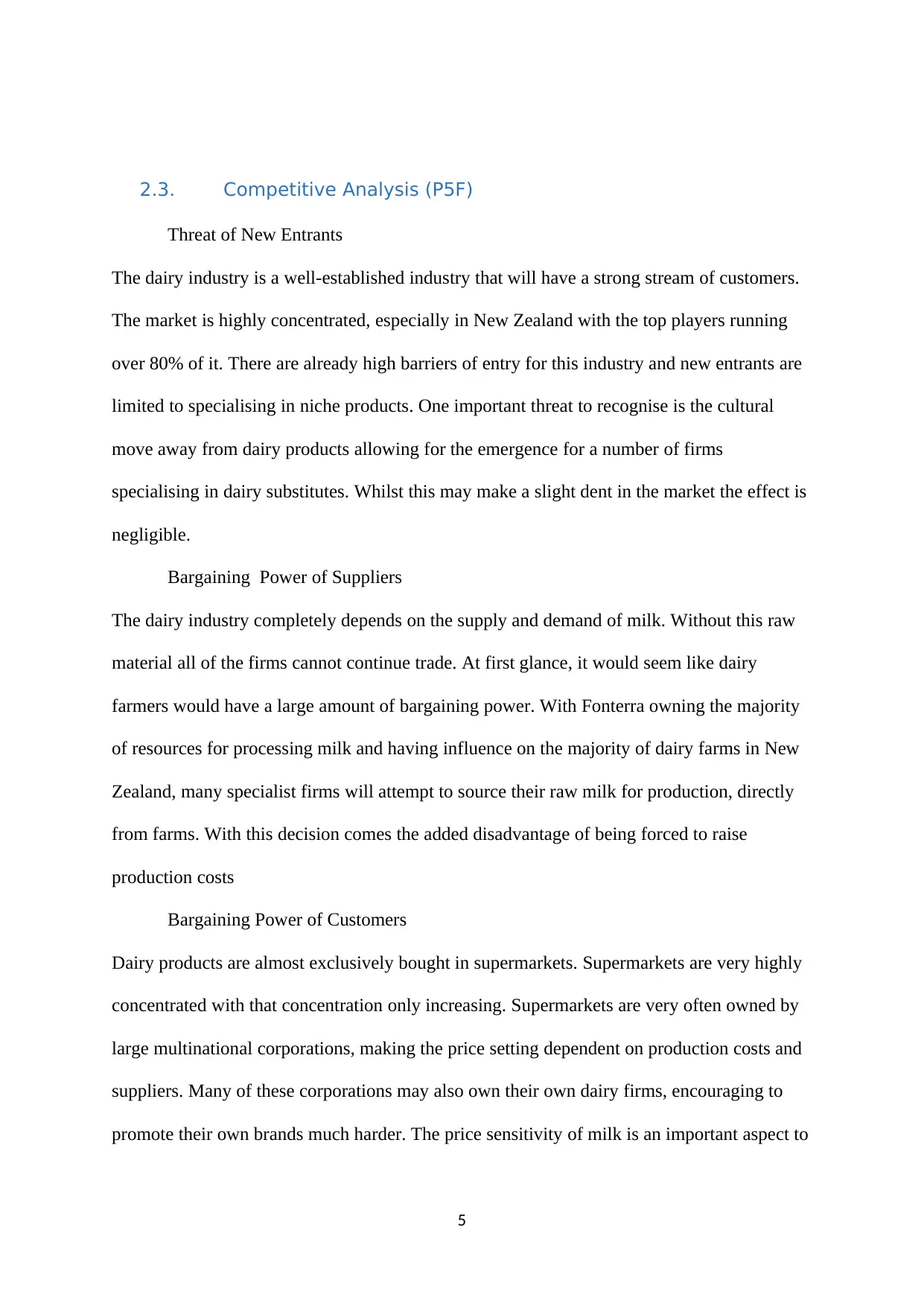
2.3. Competitive Analysis (P5F)
Threat of New Entrants
The dairy industry is a well-established industry that will have a strong stream of customers.
The market is highly concentrated, especially in New Zealand with the top players running
over 80% of it. There are already high barriers of entry for this industry and new entrants are
limited to specialising in niche products. One important threat to recognise is the cultural
move away from dairy products allowing for the emergence for a number of firms
specialising in dairy substitutes. Whilst this may make a slight dent in the market the effect is
negligible.
Bargaining Power of Suppliers
The dairy industry completely depends on the supply and demand of milk. Without this raw
material all of the firms cannot continue trade. At first glance, it would seem like dairy
farmers would have a large amount of bargaining power. With Fonterra owning the majority
of resources for processing milk and having influence on the majority of dairy farms in New
Zealand, many specialist firms will attempt to source their raw milk for production, directly
from farms. With this decision comes the added disadvantage of being forced to raise
production costs
Bargaining Power of Customers
Dairy products are almost exclusively bought in supermarkets. Supermarkets are very highly
concentrated with that concentration only increasing. Supermarkets are very often owned by
large multinational corporations, making the price setting dependent on production costs and
suppliers. Many of these corporations may also own their own dairy firms, encouraging to
promote their own brands much harder. The price sensitivity of milk is an important aspect to
5
Threat of New Entrants
The dairy industry is a well-established industry that will have a strong stream of customers.
The market is highly concentrated, especially in New Zealand with the top players running
over 80% of it. There are already high barriers of entry for this industry and new entrants are
limited to specialising in niche products. One important threat to recognise is the cultural
move away from dairy products allowing for the emergence for a number of firms
specialising in dairy substitutes. Whilst this may make a slight dent in the market the effect is
negligible.
Bargaining Power of Suppliers
The dairy industry completely depends on the supply and demand of milk. Without this raw
material all of the firms cannot continue trade. At first glance, it would seem like dairy
farmers would have a large amount of bargaining power. With Fonterra owning the majority
of resources for processing milk and having influence on the majority of dairy farms in New
Zealand, many specialist firms will attempt to source their raw milk for production, directly
from farms. With this decision comes the added disadvantage of being forced to raise
production costs
Bargaining Power of Customers
Dairy products are almost exclusively bought in supermarkets. Supermarkets are very highly
concentrated with that concentration only increasing. Supermarkets are very often owned by
large multinational corporations, making the price setting dependent on production costs and
suppliers. Many of these corporations may also own their own dairy firms, encouraging to
promote their own brands much harder. The price sensitivity of milk is an important aspect to
5
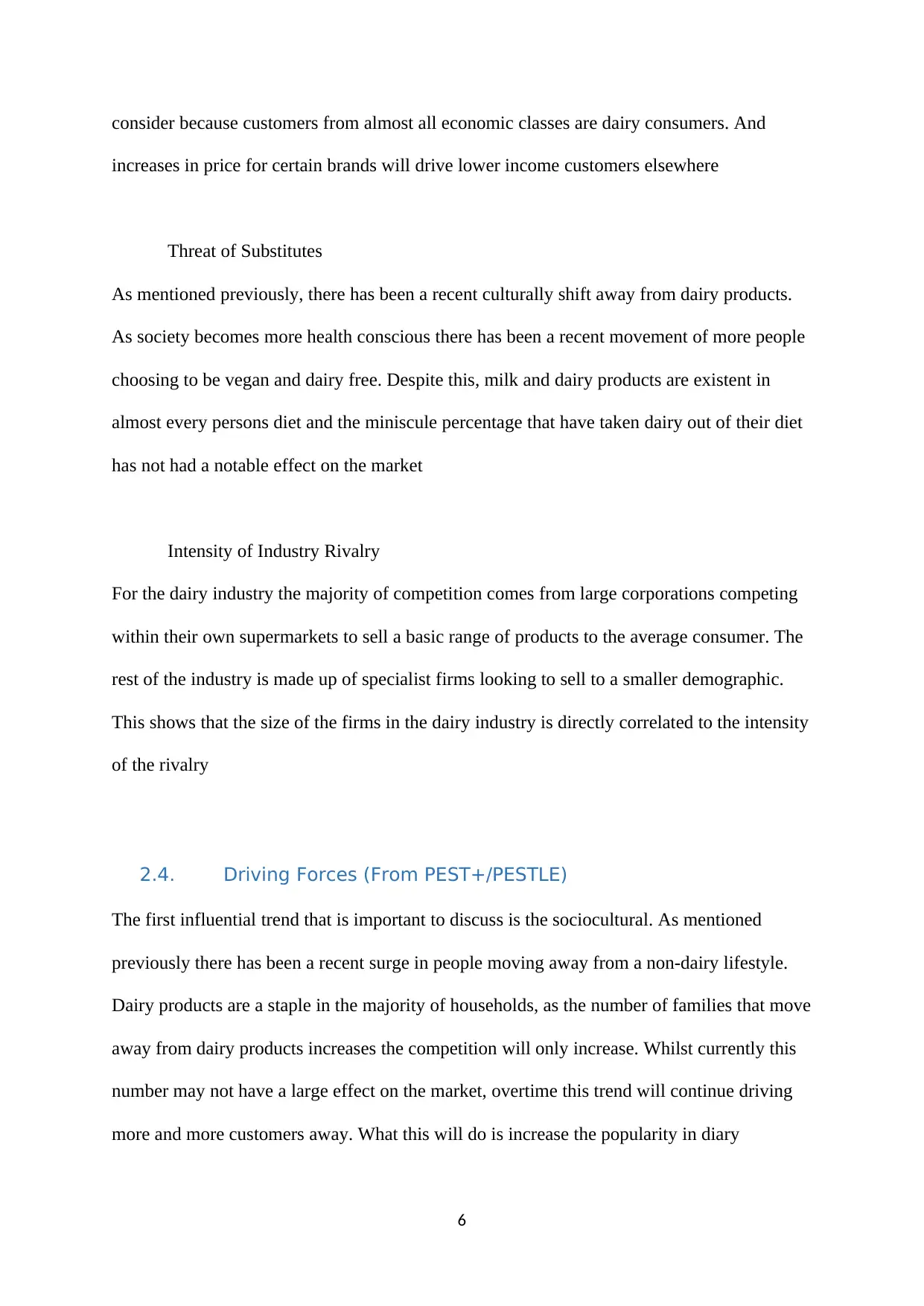
consider because customers from almost all economic classes are dairy consumers. And
increases in price for certain brands will drive lower income customers elsewhere
Threat of Substitutes
As mentioned previously, there has been a recent culturally shift away from dairy products.
As society becomes more health conscious there has been a recent movement of more people
choosing to be vegan and dairy free. Despite this, milk and dairy products are existent in
almost every persons diet and the miniscule percentage that have taken dairy out of their diet
has not had a notable effect on the market
Intensity of Industry Rivalry
For the dairy industry the majority of competition comes from large corporations competing
within their own supermarkets to sell a basic range of products to the average consumer. The
rest of the industry is made up of specialist firms looking to sell to a smaller demographic.
This shows that the size of the firms in the dairy industry is directly correlated to the intensity
of the rivalry
2.4. Driving Forces (From PEST+/PESTLE)
The first influential trend that is important to discuss is the sociocultural. As mentioned
previously there has been a recent surge in people moving away from a non-dairy lifestyle.
Dairy products are a staple in the majority of households, as the number of families that move
away from dairy products increases the competition will only increase. Whilst currently this
number may not have a large effect on the market, overtime this trend will continue driving
more and more customers away. What this will do is increase the popularity in diary
6
increases in price for certain brands will drive lower income customers elsewhere
Threat of Substitutes
As mentioned previously, there has been a recent culturally shift away from dairy products.
As society becomes more health conscious there has been a recent movement of more people
choosing to be vegan and dairy free. Despite this, milk and dairy products are existent in
almost every persons diet and the miniscule percentage that have taken dairy out of their diet
has not had a notable effect on the market
Intensity of Industry Rivalry
For the dairy industry the majority of competition comes from large corporations competing
within their own supermarkets to sell a basic range of products to the average consumer. The
rest of the industry is made up of specialist firms looking to sell to a smaller demographic.
This shows that the size of the firms in the dairy industry is directly correlated to the intensity
of the rivalry
2.4. Driving Forces (From PEST+/PESTLE)
The first influential trend that is important to discuss is the sociocultural. As mentioned
previously there has been a recent surge in people moving away from a non-dairy lifestyle.
Dairy products are a staple in the majority of households, as the number of families that move
away from dairy products increases the competition will only increase. Whilst currently this
number may not have a large effect on the market, overtime this trend will continue driving
more and more customers away. What this will do is increase the popularity in diary
6
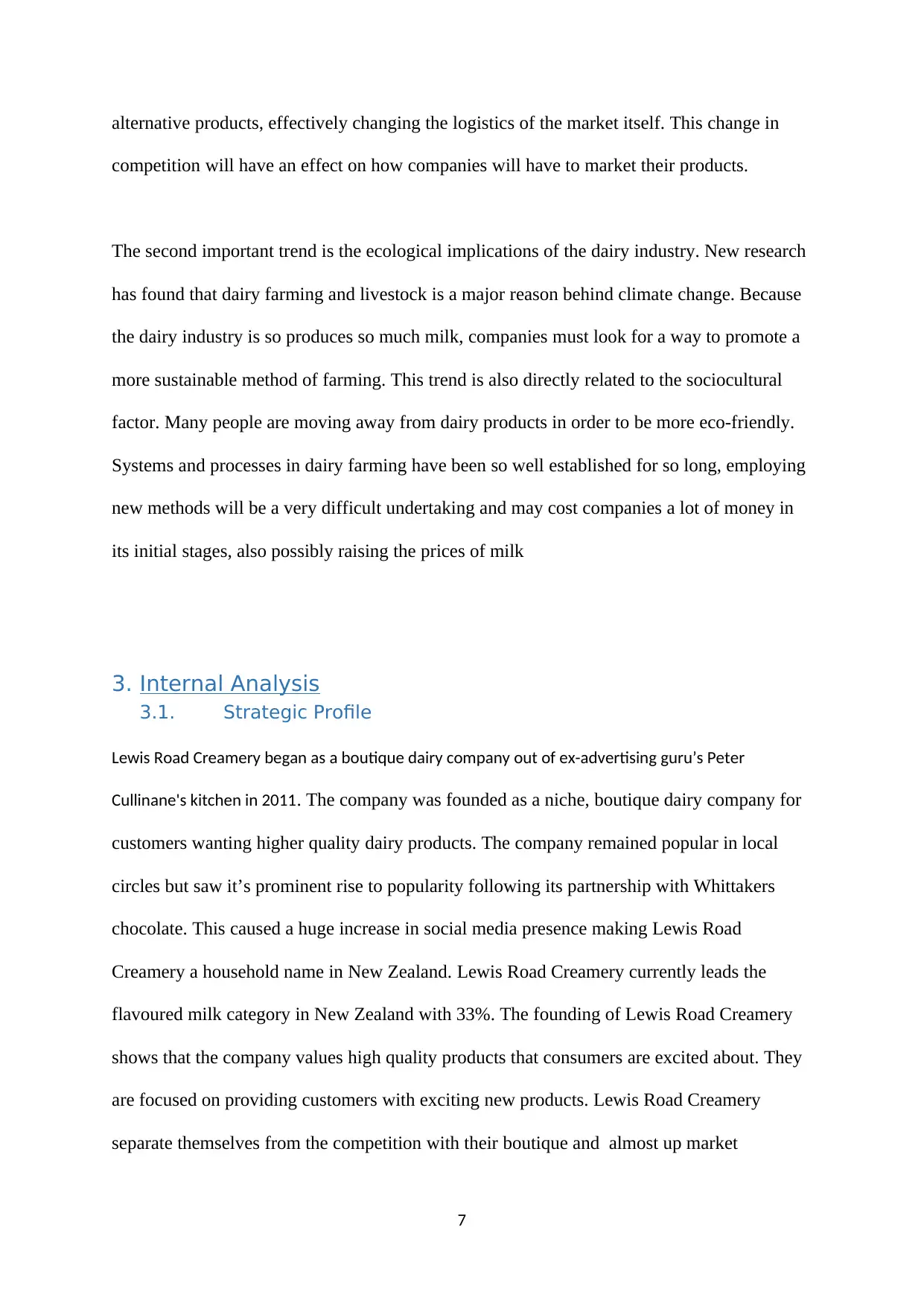
alternative products, effectively changing the logistics of the market itself. This change in
competition will have an effect on how companies will have to market their products.
The second important trend is the ecological implications of the dairy industry. New research
has found that dairy farming and livestock is a major reason behind climate change. Because
the dairy industry is so produces so much milk, companies must look for a way to promote a
more sustainable method of farming. This trend is also directly related to the sociocultural
factor. Many people are moving away from dairy products in order to be more eco-friendly.
Systems and processes in dairy farming have been so well established for so long, employing
new methods will be a very difficult undertaking and may cost companies a lot of money in
its initial stages, also possibly raising the prices of milk
3. Internal Analysis
3.1. Strategic Profile
Lewis Road Creamery began as a boutique dairy company out of ex-advertising guru’s Peter
Cullinane's kitchen in 2011. The company was founded as a niche, boutique dairy company for
customers wanting higher quality dairy products. The company remained popular in local
circles but saw it’s prominent rise to popularity following its partnership with Whittakers
chocolate. This caused a huge increase in social media presence making Lewis Road
Creamery a household name in New Zealand. Lewis Road Creamery currently leads the
flavoured milk category in New Zealand with 33%. The founding of Lewis Road Creamery
shows that the company values high quality products that consumers are excited about. They
are focused on providing customers with exciting new products. Lewis Road Creamery
separate themselves from the competition with their boutique and almost up market
7
competition will have an effect on how companies will have to market their products.
The second important trend is the ecological implications of the dairy industry. New research
has found that dairy farming and livestock is a major reason behind climate change. Because
the dairy industry is so produces so much milk, companies must look for a way to promote a
more sustainable method of farming. This trend is also directly related to the sociocultural
factor. Many people are moving away from dairy products in order to be more eco-friendly.
Systems and processes in dairy farming have been so well established for so long, employing
new methods will be a very difficult undertaking and may cost companies a lot of money in
its initial stages, also possibly raising the prices of milk
3. Internal Analysis
3.1. Strategic Profile
Lewis Road Creamery began as a boutique dairy company out of ex-advertising guru’s Peter
Cullinane's kitchen in 2011. The company was founded as a niche, boutique dairy company for
customers wanting higher quality dairy products. The company remained popular in local
circles but saw it’s prominent rise to popularity following its partnership with Whittakers
chocolate. This caused a huge increase in social media presence making Lewis Road
Creamery a household name in New Zealand. Lewis Road Creamery currently leads the
flavoured milk category in New Zealand with 33%. The founding of Lewis Road Creamery
shows that the company values high quality products that consumers are excited about. They
are focused on providing customers with exciting new products. Lewis Road Creamery
separate themselves from the competition with their boutique and almost up market
7
Paraphrase This Document
Need a fresh take? Get an instant paraphrase of this document with our AI Paraphraser
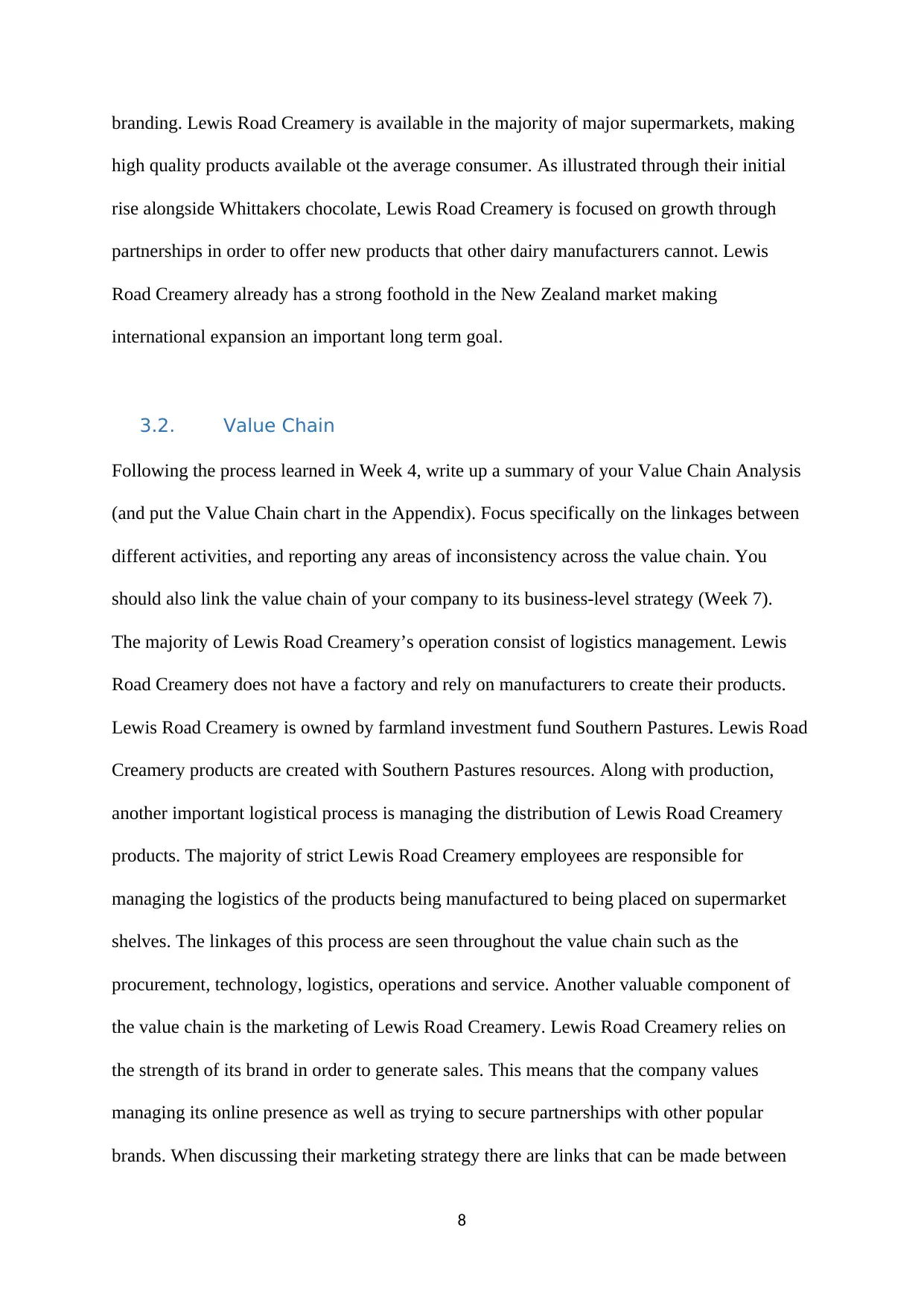
branding. Lewis Road Creamery is available in the majority of major supermarkets, making
high quality products available ot the average consumer. As illustrated through their initial
rise alongside Whittakers chocolate, Lewis Road Creamery is focused on growth through
partnerships in order to offer new products that other dairy manufacturers cannot. Lewis
Road Creamery already has a strong foothold in the New Zealand market making
international expansion an important long term goal.
3.2. Value Chain
Following the process learned in Week 4, write up a summary of your Value Chain Analysis
(and put the Value Chain chart in the Appendix). Focus specifically on the linkages between
different activities, and reporting any areas of inconsistency across the value chain. You
should also link the value chain of your company to its business-level strategy (Week 7).
The majority of Lewis Road Creamery’s operation consist of logistics management. Lewis
Road Creamery does not have a factory and rely on manufacturers to create their products.
Lewis Road Creamery is owned by farmland investment fund Southern Pastures. Lewis Road
Creamery products are created with Southern Pastures resources. Along with production,
another important logistical process is managing the distribution of Lewis Road Creamery
products. The majority of strict Lewis Road Creamery employees are responsible for
managing the logistics of the products being manufactured to being placed on supermarket
shelves. The linkages of this process are seen throughout the value chain such as the
procurement, technology, logistics, operations and service. Another valuable component of
the value chain is the marketing of Lewis Road Creamery. Lewis Road Creamery relies on
the strength of its brand in order to generate sales. This means that the company values
managing its online presence as well as trying to secure partnerships with other popular
brands. When discussing their marketing strategy there are links that can be made between
8
high quality products available ot the average consumer. As illustrated through their initial
rise alongside Whittakers chocolate, Lewis Road Creamery is focused on growth through
partnerships in order to offer new products that other dairy manufacturers cannot. Lewis
Road Creamery already has a strong foothold in the New Zealand market making
international expansion an important long term goal.
3.2. Value Chain
Following the process learned in Week 4, write up a summary of your Value Chain Analysis
(and put the Value Chain chart in the Appendix). Focus specifically on the linkages between
different activities, and reporting any areas of inconsistency across the value chain. You
should also link the value chain of your company to its business-level strategy (Week 7).
The majority of Lewis Road Creamery’s operation consist of logistics management. Lewis
Road Creamery does not have a factory and rely on manufacturers to create their products.
Lewis Road Creamery is owned by farmland investment fund Southern Pastures. Lewis Road
Creamery products are created with Southern Pastures resources. Along with production,
another important logistical process is managing the distribution of Lewis Road Creamery
products. The majority of strict Lewis Road Creamery employees are responsible for
managing the logistics of the products being manufactured to being placed on supermarket
shelves. The linkages of this process are seen throughout the value chain such as the
procurement, technology, logistics, operations and service. Another valuable component of
the value chain is the marketing of Lewis Road Creamery. Lewis Road Creamery relies on
the strength of its brand in order to generate sales. This means that the company values
managing its online presence as well as trying to secure partnerships with other popular
brands. When discussing their marketing strategy there are links that can be made between
8
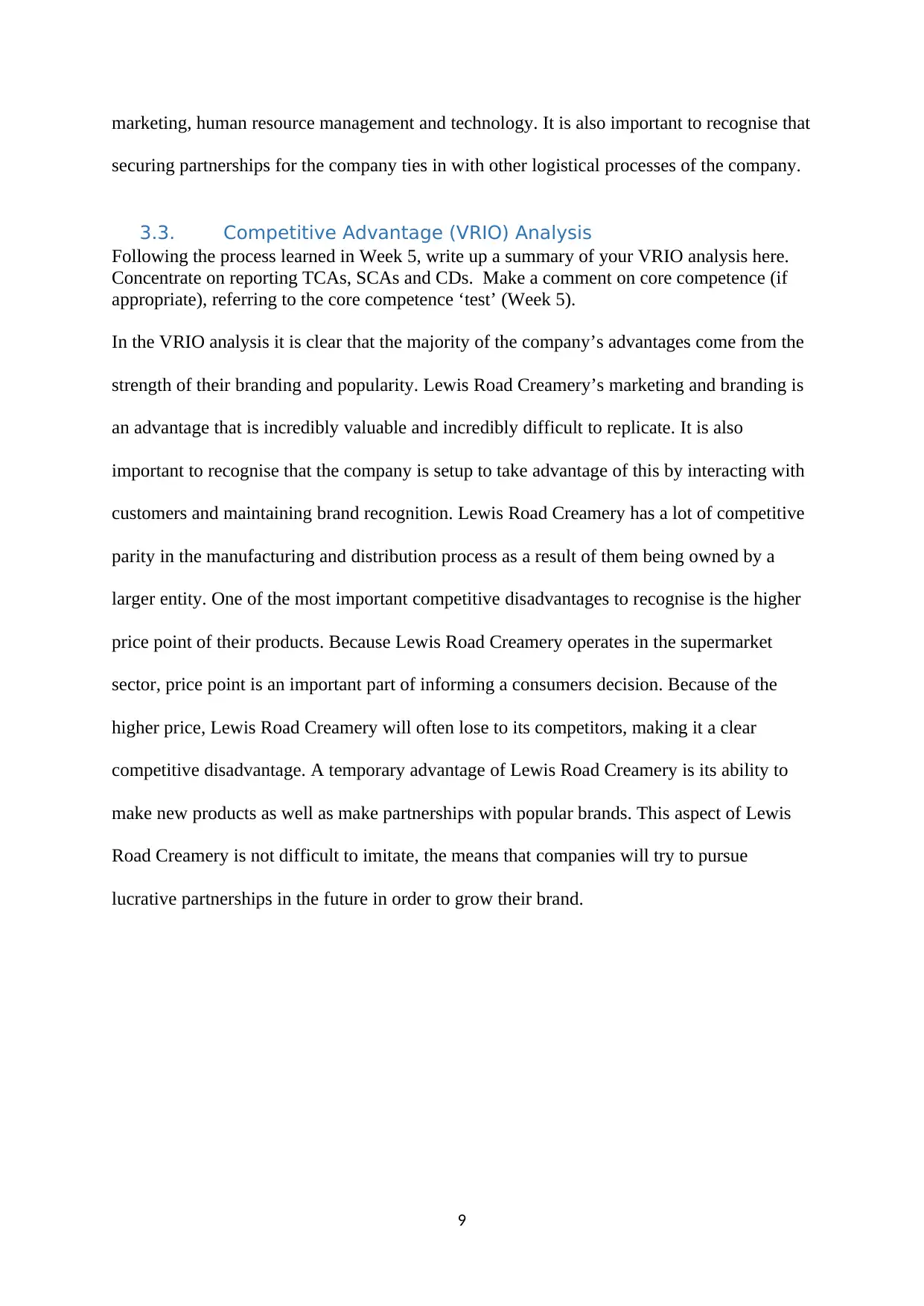
marketing, human resource management and technology. It is also important to recognise that
securing partnerships for the company ties in with other logistical processes of the company.
3.3. Competitive Advantage (VRIO) Analysis
Following the process learned in Week 5, write up a summary of your VRIO analysis here.
Concentrate on reporting TCAs, SCAs and CDs. Make a comment on core competence (if
appropriate), referring to the core competence ‘test’ (Week 5).
In the VRIO analysis it is clear that the majority of the company’s advantages come from the
strength of their branding and popularity. Lewis Road Creamery’s marketing and branding is
an advantage that is incredibly valuable and incredibly difficult to replicate. It is also
important to recognise that the company is setup to take advantage of this by interacting with
customers and maintaining brand recognition. Lewis Road Creamery has a lot of competitive
parity in the manufacturing and distribution process as a result of them being owned by a
larger entity. One of the most important competitive disadvantages to recognise is the higher
price point of their products. Because Lewis Road Creamery operates in the supermarket
sector, price point is an important part of informing a consumers decision. Because of the
higher price, Lewis Road Creamery will often lose to its competitors, making it a clear
competitive disadvantage. A temporary advantage of Lewis Road Creamery is its ability to
make new products as well as make partnerships with popular brands. This aspect of Lewis
Road Creamery is not difficult to imitate, the means that companies will try to pursue
lucrative partnerships in the future in order to grow their brand.
9
securing partnerships for the company ties in with other logistical processes of the company.
3.3. Competitive Advantage (VRIO) Analysis
Following the process learned in Week 5, write up a summary of your VRIO analysis here.
Concentrate on reporting TCAs, SCAs and CDs. Make a comment on core competence (if
appropriate), referring to the core competence ‘test’ (Week 5).
In the VRIO analysis it is clear that the majority of the company’s advantages come from the
strength of their branding and popularity. Lewis Road Creamery’s marketing and branding is
an advantage that is incredibly valuable and incredibly difficult to replicate. It is also
important to recognise that the company is setup to take advantage of this by interacting with
customers and maintaining brand recognition. Lewis Road Creamery has a lot of competitive
parity in the manufacturing and distribution process as a result of them being owned by a
larger entity. One of the most important competitive disadvantages to recognise is the higher
price point of their products. Because Lewis Road Creamery operates in the supermarket
sector, price point is an important part of informing a consumers decision. Because of the
higher price, Lewis Road Creamery will often lose to its competitors, making it a clear
competitive disadvantage. A temporary advantage of Lewis Road Creamery is its ability to
make new products as well as make partnerships with popular brands. This aspect of Lewis
Road Creamery is not difficult to imitate, the means that companies will try to pursue
lucrative partnerships in the future in order to grow their brand.
9
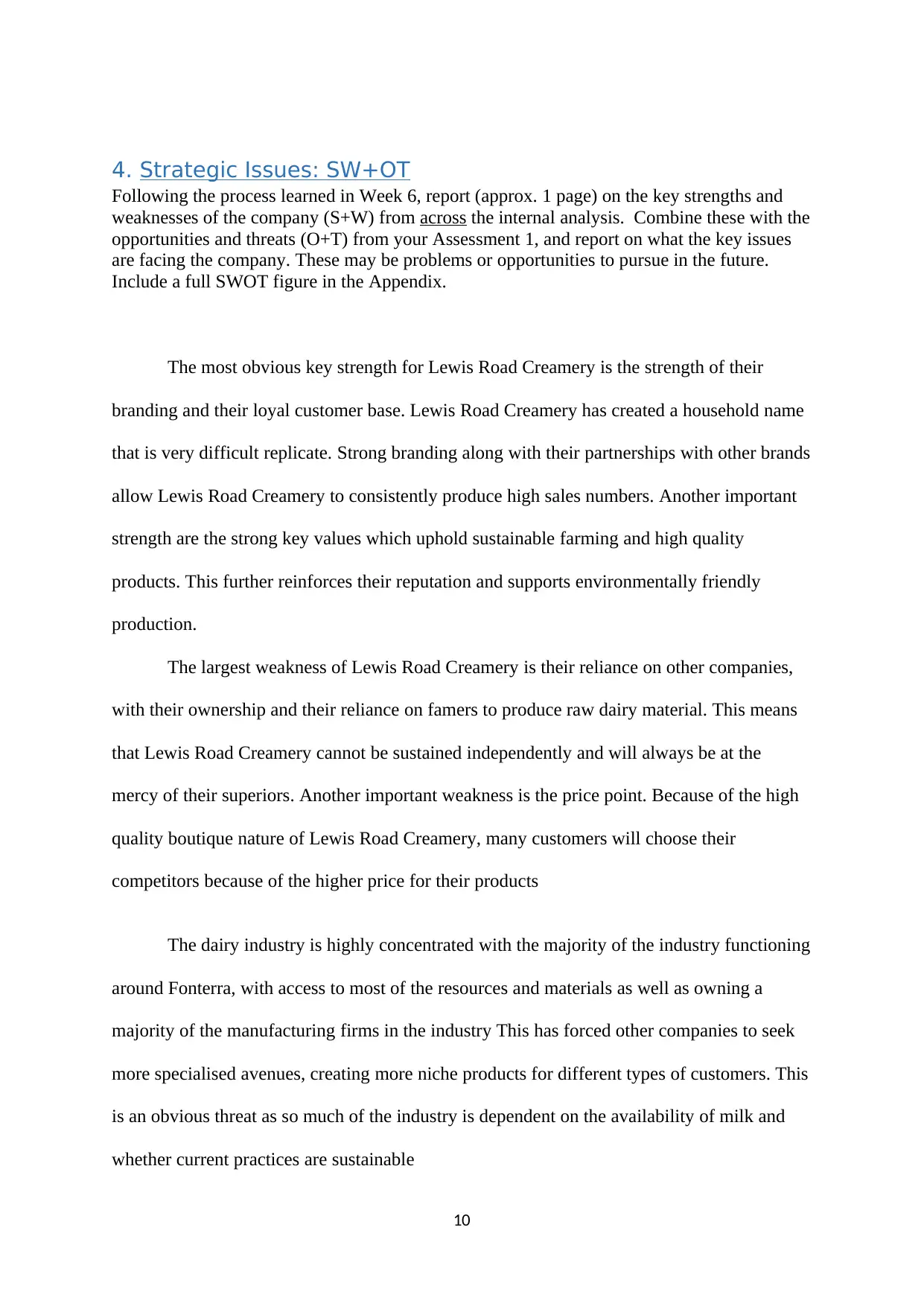
4. Strategic Issues: SW+OT
Following the process learned in Week 6, report (approx. 1 page) on the key strengths and
weaknesses of the company (S+W) from across the internal analysis. Combine these with the
opportunities and threats (O+T) from your Assessment 1, and report on what the key issues
are facing the company. These may be problems or opportunities to pursue in the future.
Include a full SWOT figure in the Appendix.
The most obvious key strength for Lewis Road Creamery is the strength of their
branding and their loyal customer base. Lewis Road Creamery has created a household name
that is very difficult replicate. Strong branding along with their partnerships with other brands
allow Lewis Road Creamery to consistently produce high sales numbers. Another important
strength are the strong key values which uphold sustainable farming and high quality
products. This further reinforces their reputation and supports environmentally friendly
production.
The largest weakness of Lewis Road Creamery is their reliance on other companies,
with their ownership and their reliance on famers to produce raw dairy material. This means
that Lewis Road Creamery cannot be sustained independently and will always be at the
mercy of their superiors. Another important weakness is the price point. Because of the high
quality boutique nature of Lewis Road Creamery, many customers will choose their
competitors because of the higher price for their products
The dairy industry is highly concentrated with the majority of the industry functioning
around Fonterra, with access to most of the resources and materials as well as owning a
majority of the manufacturing firms in the industry This has forced other companies to seek
more specialised avenues, creating more niche products for different types of customers. This
is an obvious threat as so much of the industry is dependent on the availability of milk and
whether current practices are sustainable
10
Following the process learned in Week 6, report (approx. 1 page) on the key strengths and
weaknesses of the company (S+W) from across the internal analysis. Combine these with the
opportunities and threats (O+T) from your Assessment 1, and report on what the key issues
are facing the company. These may be problems or opportunities to pursue in the future.
Include a full SWOT figure in the Appendix.
The most obvious key strength for Lewis Road Creamery is the strength of their
branding and their loyal customer base. Lewis Road Creamery has created a household name
that is very difficult replicate. Strong branding along with their partnerships with other brands
allow Lewis Road Creamery to consistently produce high sales numbers. Another important
strength are the strong key values which uphold sustainable farming and high quality
products. This further reinforces their reputation and supports environmentally friendly
production.
The largest weakness of Lewis Road Creamery is their reliance on other companies,
with their ownership and their reliance on famers to produce raw dairy material. This means
that Lewis Road Creamery cannot be sustained independently and will always be at the
mercy of their superiors. Another important weakness is the price point. Because of the high
quality boutique nature of Lewis Road Creamery, many customers will choose their
competitors because of the higher price for their products
The dairy industry is highly concentrated with the majority of the industry functioning
around Fonterra, with access to most of the resources and materials as well as owning a
majority of the manufacturing firms in the industry This has forced other companies to seek
more specialised avenues, creating more niche products for different types of customers. This
is an obvious threat as so much of the industry is dependent on the availability of milk and
whether current practices are sustainable
10
Secure Best Marks with AI Grader
Need help grading? Try our AI Grader for instant feedback on your assignments.
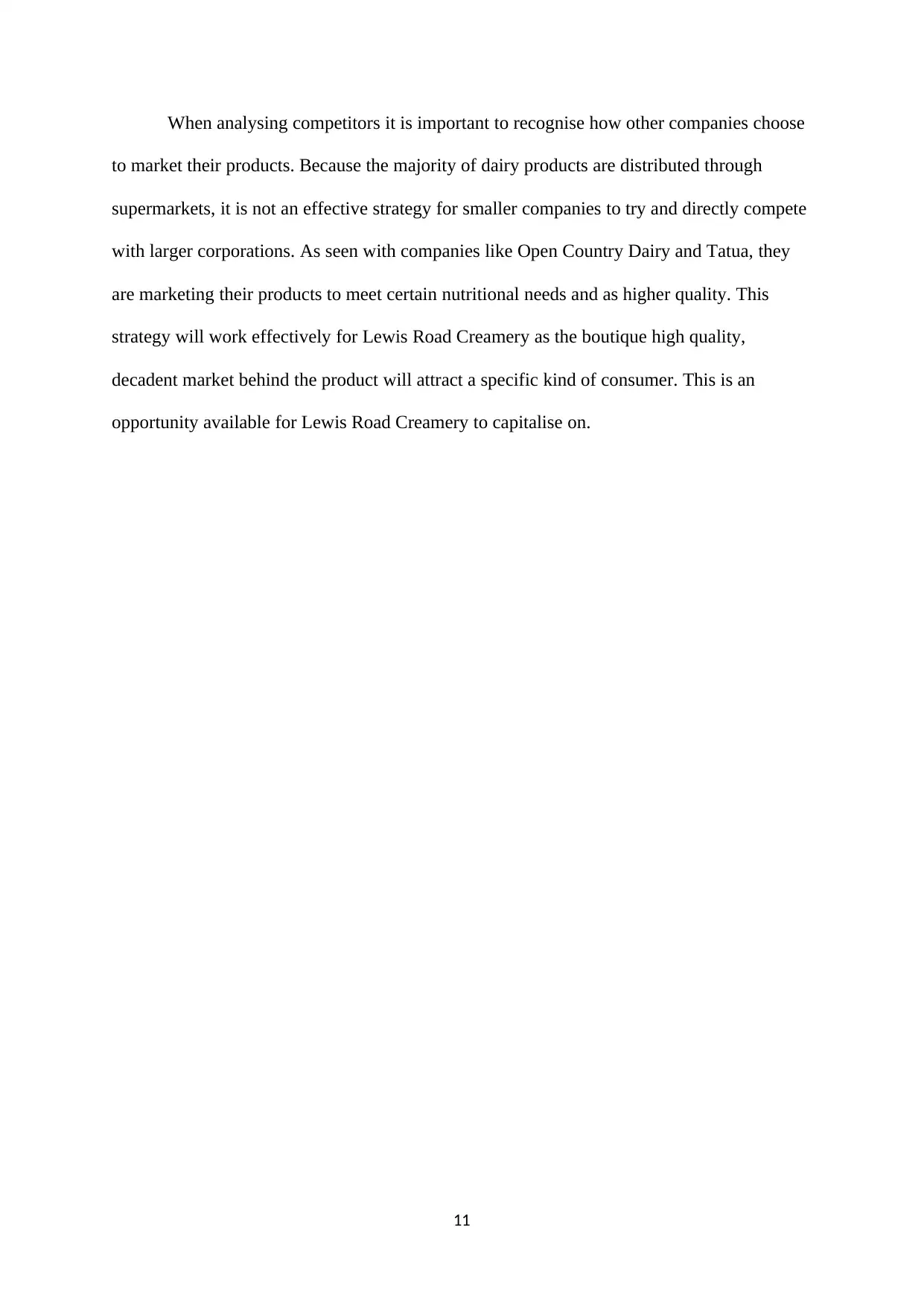
When analysing competitors it is important to recognise how other companies choose
to market their products. Because the majority of dairy products are distributed through
supermarkets, it is not an effective strategy for smaller companies to try and directly compete
with larger corporations. As seen with companies like Open Country Dairy and Tatua, they
are marketing their products to meet certain nutritional needs and as higher quality. This
strategy will work effectively for Lewis Road Creamery as the boutique high quality,
decadent market behind the product will attract a specific kind of consumer. This is an
opportunity available for Lewis Road Creamery to capitalise on.
11
to market their products. Because the majority of dairy products are distributed through
supermarkets, it is not an effective strategy for smaller companies to try and directly compete
with larger corporations. As seen with companies like Open Country Dairy and Tatua, they
are marketing their products to meet certain nutritional needs and as higher quality. This
strategy will work effectively for Lewis Road Creamery as the boutique high quality,
decadent market behind the product will attract a specific kind of consumer. This is an
opportunity available for Lewis Road Creamery to capitalise on.
11
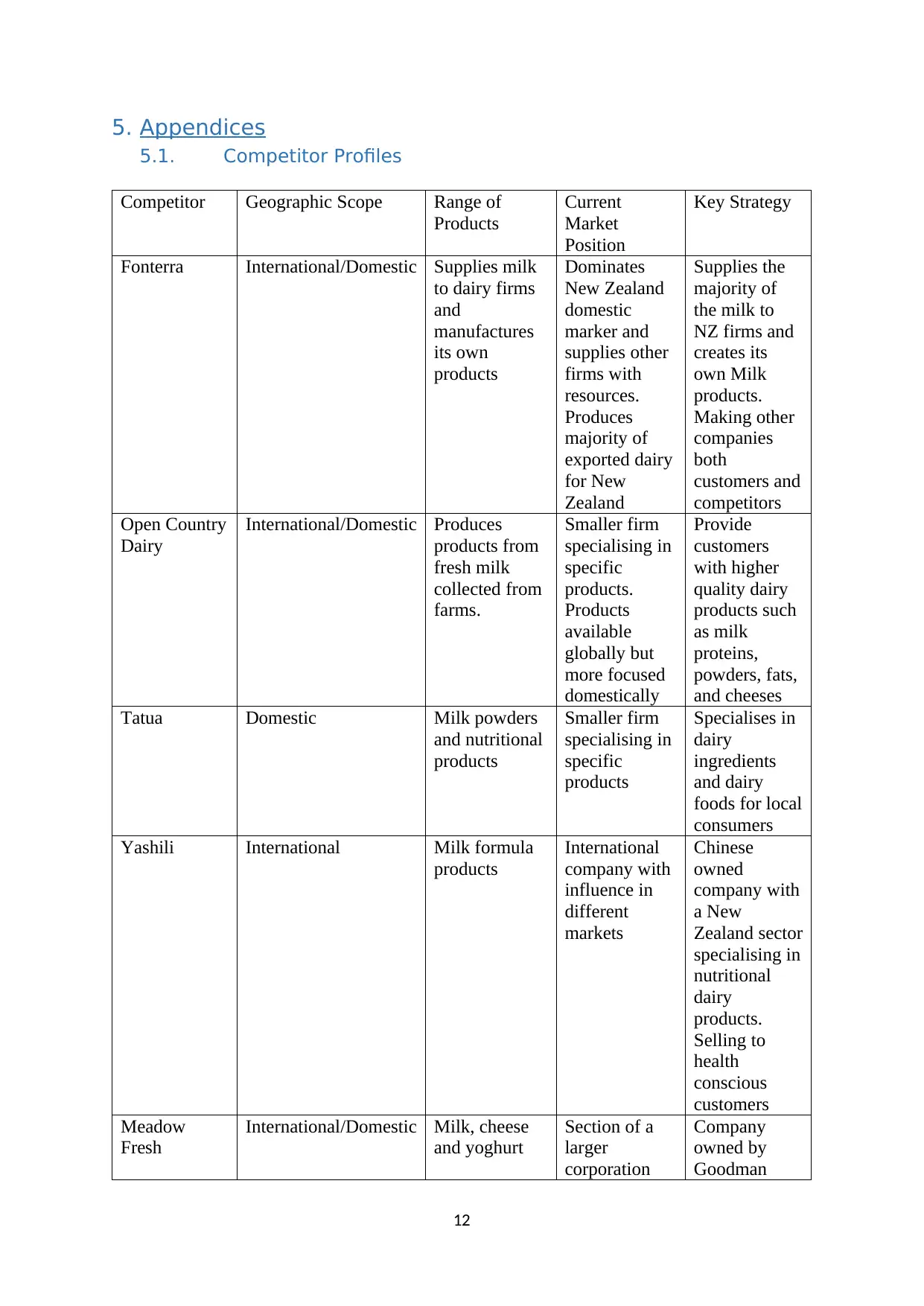
5. Appendices
5.1. Competitor Profiles
Competitor Geographic Scope Range of
Products
Current
Market
Position
Key Strategy
Fonterra International/Domestic Supplies milk
to dairy firms
and
manufactures
its own
products
Dominates
New Zealand
domestic
marker and
supplies other
firms with
resources.
Produces
majority of
exported dairy
for New
Zealand
Supplies the
majority of
the milk to
NZ firms and
creates its
own Milk
products.
Making other
companies
both
customers and
competitors
Open Country
Dairy
International/Domestic Produces
products from
fresh milk
collected from
farms.
Smaller firm
specialising in
specific
products.
Products
available
globally but
more focused
domestically
Provide
customers
with higher
quality dairy
products such
as milk
proteins,
powders, fats,
and cheeses
Tatua Domestic Milk powders
and nutritional
products
Smaller firm
specialising in
specific
products
Specialises in
dairy
ingredients
and dairy
foods for local
consumers
Yashili International Milk formula
products
International
company with
influence in
different
markets
Chinese
owned
company with
a New
Zealand sector
specialising in
nutritional
dairy
products.
Selling to
health
conscious
customers
Meadow
Fresh
International/Domestic Milk, cheese
and yoghurt
Section of a
larger
corporation
Company
owned by
Goodman
12
5.1. Competitor Profiles
Competitor Geographic Scope Range of
Products
Current
Market
Position
Key Strategy
Fonterra International/Domestic Supplies milk
to dairy firms
and
manufactures
its own
products
Dominates
New Zealand
domestic
marker and
supplies other
firms with
resources.
Produces
majority of
exported dairy
for New
Zealand
Supplies the
majority of
the milk to
NZ firms and
creates its
own Milk
products.
Making other
companies
both
customers and
competitors
Open Country
Dairy
International/Domestic Produces
products from
fresh milk
collected from
farms.
Smaller firm
specialising in
specific
products.
Products
available
globally but
more focused
domestically
Provide
customers
with higher
quality dairy
products such
as milk
proteins,
powders, fats,
and cheeses
Tatua Domestic Milk powders
and nutritional
products
Smaller firm
specialising in
specific
products
Specialises in
dairy
ingredients
and dairy
foods for local
consumers
Yashili International Milk formula
products
International
company with
influence in
different
markets
Chinese
owned
company with
a New
Zealand sector
specialising in
nutritional
dairy
products.
Selling to
health
conscious
customers
Meadow
Fresh
International/Domestic Milk, cheese
and yoghurt
Section of a
larger
corporation
Company
owned by
Goodman
12
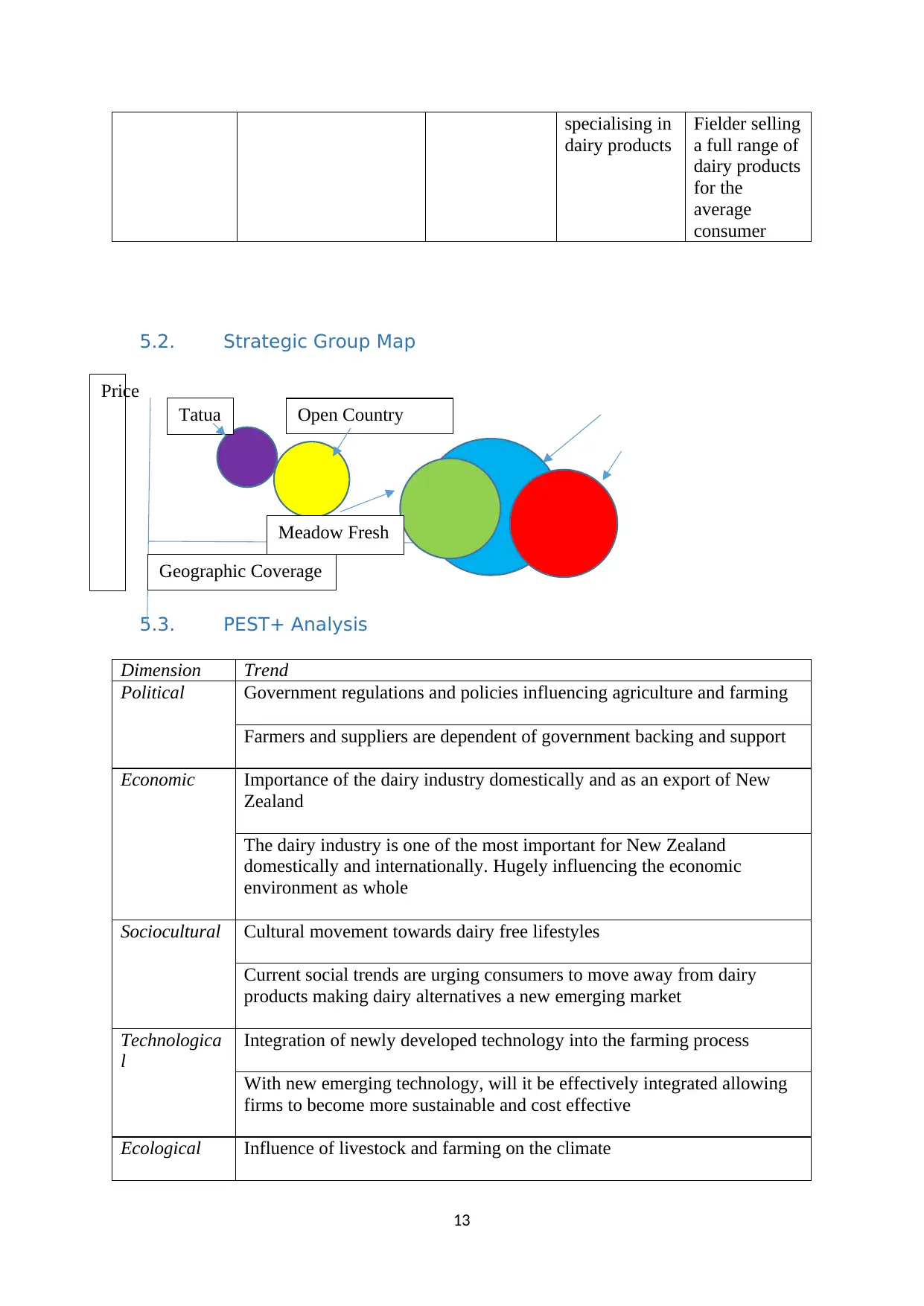
specialising in
dairy products
Fielder selling
a full range of
dairy products
for the
average
consumer
5.2. Strategic Group Map
5.3. PEST+ Analysis
Dimension Trend
Political Government regulations and policies influencing agriculture and farming
Farmers and suppliers are dependent of government backing and support
Economic Importance of the dairy industry domestically and as an export of New
Zealand
The dairy industry is one of the most important for New Zealand
domestically and internationally. Hugely influencing the economic
environment as whole
Sociocultural Cultural movement towards dairy free lifestyles
Current social trends are urging consumers to move away from dairy
products making dairy alternatives a new emerging market
Technologica
l
Integration of newly developed technology into the farming process
With new emerging technology, will it be effectively integrated allowing
firms to become more sustainable and cost effective
Ecological Influence of livestock and farming on the climate
13
Price
Geographic Coverage
Tatua Open Country
Dairy
Meadow Fresh
dairy products
Fielder selling
a full range of
dairy products
for the
average
consumer
5.2. Strategic Group Map
5.3. PEST+ Analysis
Dimension Trend
Political Government regulations and policies influencing agriculture and farming
Farmers and suppliers are dependent of government backing and support
Economic Importance of the dairy industry domestically and as an export of New
Zealand
The dairy industry is one of the most important for New Zealand
domestically and internationally. Hugely influencing the economic
environment as whole
Sociocultural Cultural movement towards dairy free lifestyles
Current social trends are urging consumers to move away from dairy
products making dairy alternatives a new emerging market
Technologica
l
Integration of newly developed technology into the farming process
With new emerging technology, will it be effectively integrated allowing
firms to become more sustainable and cost effective
Ecological Influence of livestock and farming on the climate
13
Price
Geographic Coverage
Tatua Open Country
Dairy
Meadow Fresh
Paraphrase This Document
Need a fresh take? Get an instant paraphrase of this document with our AI Paraphraser
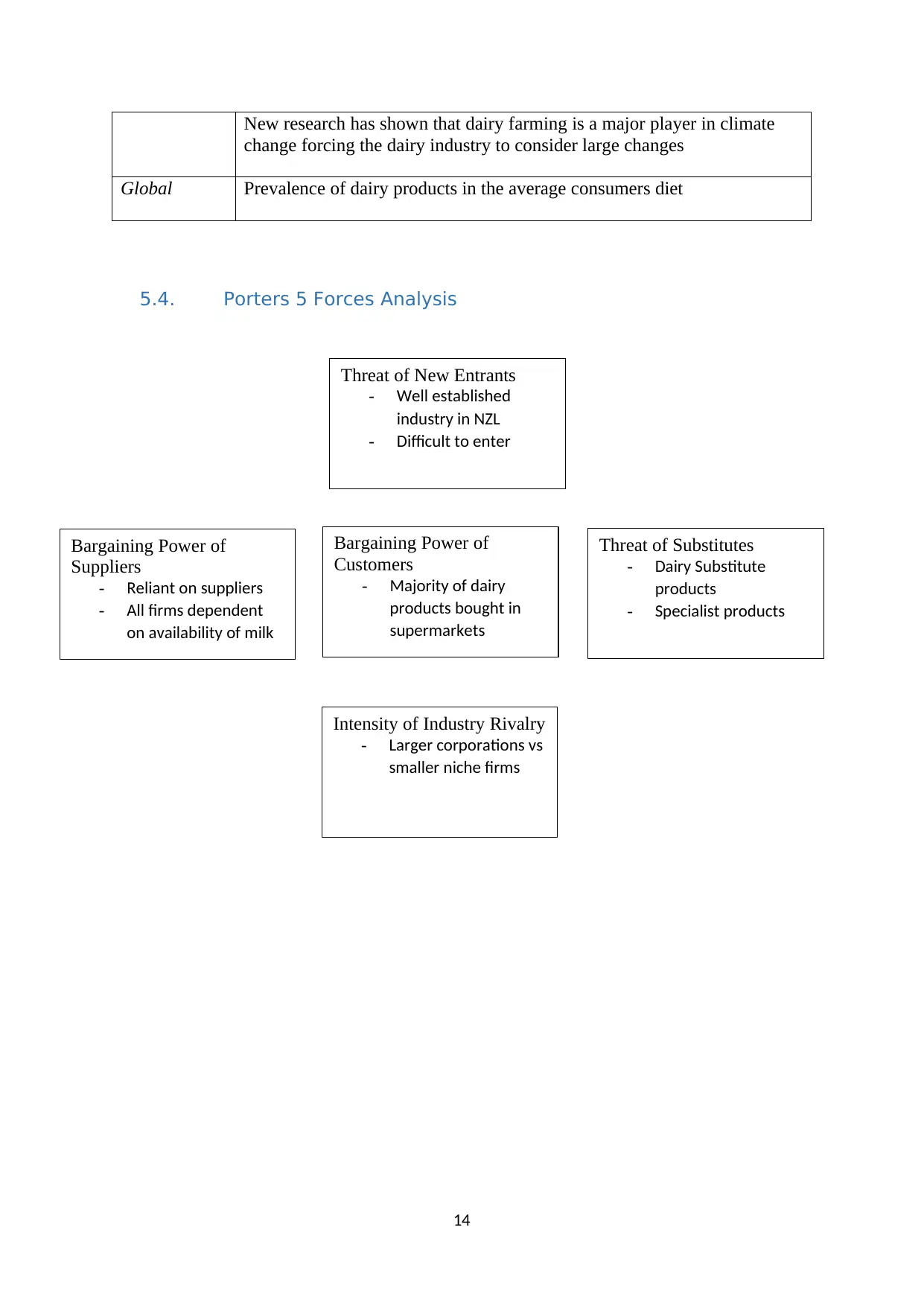
New research has shown that dairy farming is a major player in climate
change forcing the dairy industry to consider large changes
Global Prevalence of dairy products in the average consumers diet
5.4. Porters 5 Forces Analysis
14
Threat of New Entrants
- Well established
industry in NZL
- Difficult to enter
Bargaining Power of
Suppliers
- Reliant on suppliers
- All firms dependent
on availability of milk
Intensity of Industry Rivalry
- Larger corporations vs
smaller niche firms
Threat of Substitutes
- Dairy Substitute
products
- Specialist products
Bargaining Power of
Customers
- Majority of dairy
products bought in
supermarkets
change forcing the dairy industry to consider large changes
Global Prevalence of dairy products in the average consumers diet
5.4. Porters 5 Forces Analysis
14
Threat of New Entrants
- Well established
industry in NZL
- Difficult to enter
Bargaining Power of
Suppliers
- Reliant on suppliers
- All firms dependent
on availability of milk
Intensity of Industry Rivalry
- Larger corporations vs
smaller niche firms
Threat of Substitutes
- Dairy Substitute
products
- Specialist products
Bargaining Power of
Customers
- Majority of dairy
products bought in
supermarkets
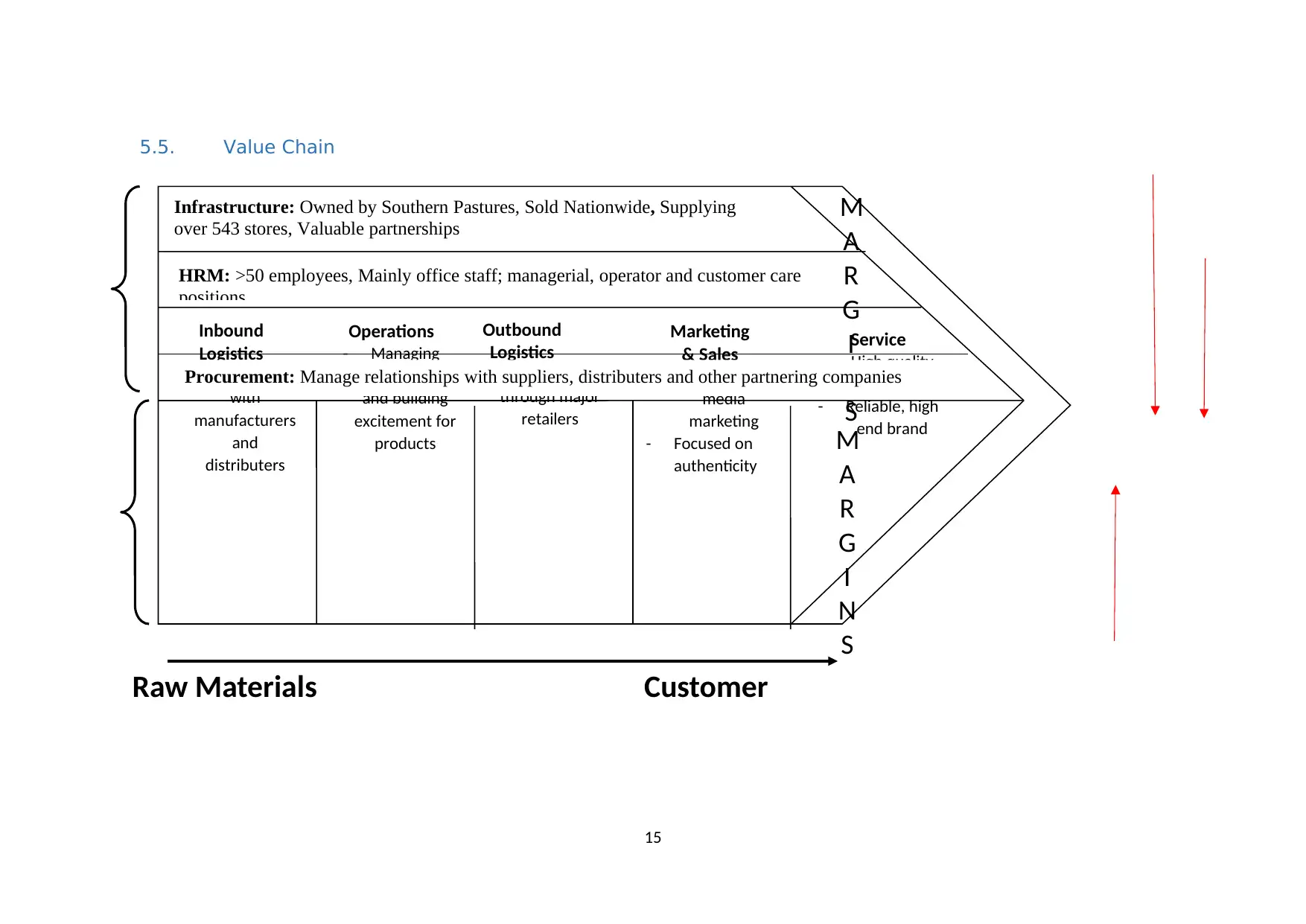
5.5. Value Chain
15
IT: Large social media presence, management of distribution to major supermarkets
nationwide, New products created in house
M
A
R
G
I
N
S
M
A
R
G
I
N
S
Inbound
Logistics
- Organising
with
manufacturers
and
distributers
Operations
- Managing
partnerships
and building
excitement for
products
Outbound
Logistics
- Distributed
through major
retailers
Service
- High quality
products
- Reliable, high
end brand
Marketing
& Sales
- High social
media
marketing
- Focused on
authenticity
CustomerRaw Materials
Infrastructure: Owned by Southern Pastures, Sold Nationwide, Supplying
over 543 stores, Valuable partnerships
HRM: >50 employees, Mainly office staff; managerial, operator and customer care
positions
Procurement: Manage relationships with suppliers, distributers and other partnering companies
15
IT: Large social media presence, management of distribution to major supermarkets
nationwide, New products created in house
M
A
R
G
I
N
S
M
A
R
G
I
N
S
Inbound
Logistics
- Organising
with
manufacturers
and
distributers
Operations
- Managing
partnerships
and building
excitement for
products
Outbound
Logistics
- Distributed
through major
retailers
Service
- High quality
products
- Reliable, high
end brand
Marketing
& Sales
- High social
media
marketing
- Focused on
authenticity
CustomerRaw Materials
Infrastructure: Owned by Southern Pastures, Sold Nationwide, Supplying
over 543 stores, Valuable partnerships
HRM: >50 employees, Mainly office staff; managerial, operator and customer care
positions
Procurement: Manage relationships with suppliers, distributers and other partnering companies
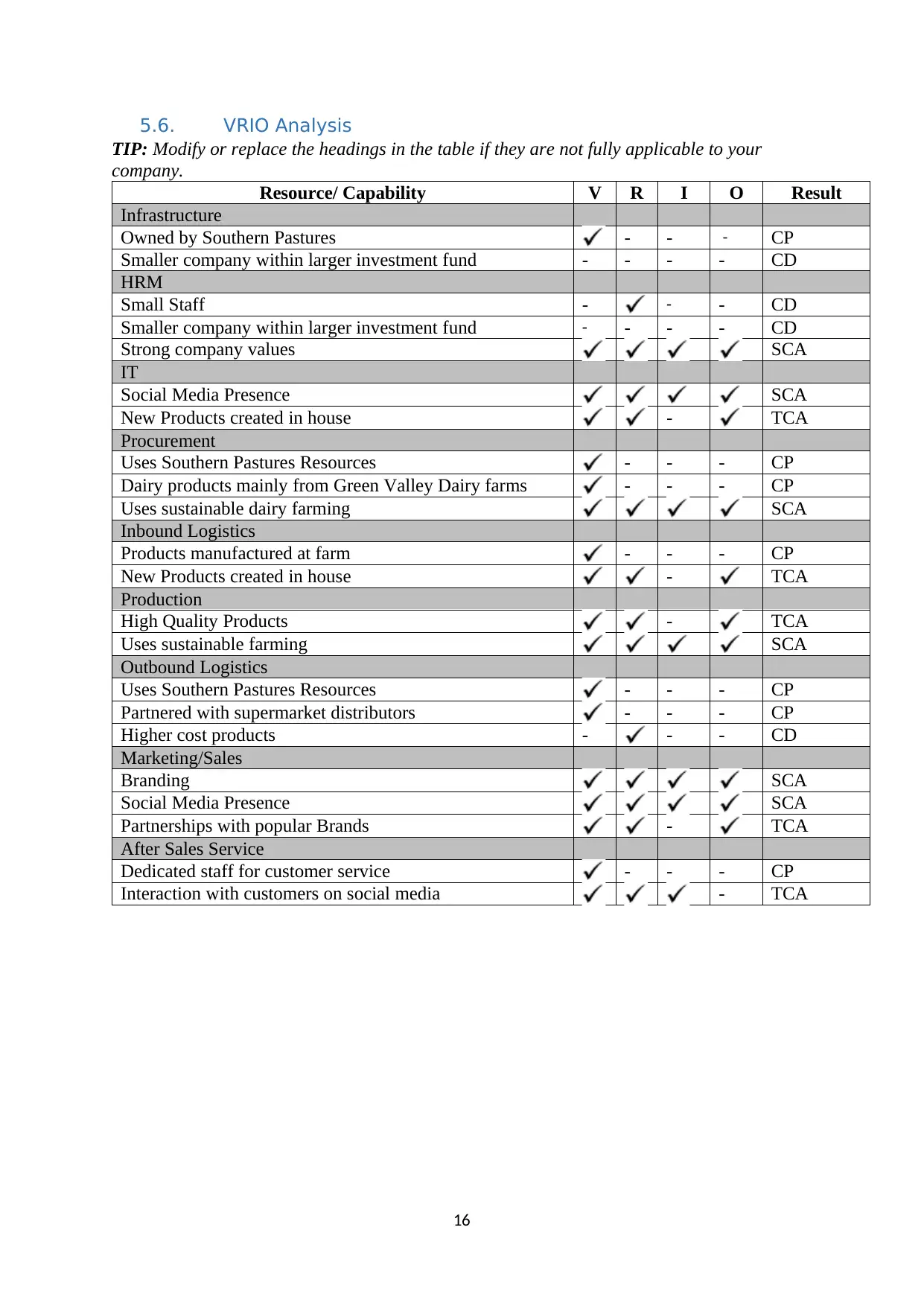
5.6. VRIO Analysis
TIP: Modify or replace the headings in the table if they are not fully applicable to your
company.
Resource/ Capability V R I O Result
Infrastructure
Owned by Southern Pastures - - - CP
Smaller company within larger investment fund - - - - CD
HRM
Small Staff - - - CD
Smaller company within larger investment fund - - - - CD
Strong company values SCA
IT
Social Media Presence SCA
New Products created in house - TCA
Procurement
Uses Southern Pastures Resources - - - CP
Dairy products mainly from Green Valley Dairy farms - - - CP
Uses sustainable dairy farming SCA
Inbound Logistics
Products manufactured at farm - - - CP
New Products created in house - TCA
Production
High Quality Products - TCA
Uses sustainable farming SCA
Outbound Logistics
Uses Southern Pastures Resources - - - CP
Partnered with supermarket distributors - - - CP
Higher cost products - - - CD
Marketing/Sales
Branding SCA
Social Media Presence SCA
Partnerships with popular Brands - TCA
After Sales Service
Dedicated staff for customer service - - - CP
Interaction with customers on social media - TCA
16
TIP: Modify or replace the headings in the table if they are not fully applicable to your
company.
Resource/ Capability V R I O Result
Infrastructure
Owned by Southern Pastures - - - CP
Smaller company within larger investment fund - - - - CD
HRM
Small Staff - - - CD
Smaller company within larger investment fund - - - - CD
Strong company values SCA
IT
Social Media Presence SCA
New Products created in house - TCA
Procurement
Uses Southern Pastures Resources - - - CP
Dairy products mainly from Green Valley Dairy farms - - - CP
Uses sustainable dairy farming SCA
Inbound Logistics
Products manufactured at farm - - - CP
New Products created in house - TCA
Production
High Quality Products - TCA
Uses sustainable farming SCA
Outbound Logistics
Uses Southern Pastures Resources - - - CP
Partnered with supermarket distributors - - - CP
Higher cost products - - - CD
Marketing/Sales
Branding SCA
Social Media Presence SCA
Partnerships with popular Brands - TCA
After Sales Service
Dedicated staff for customer service - - - CP
Interaction with customers on social media - TCA
16
Secure Best Marks with AI Grader
Need help grading? Try our AI Grader for instant feedback on your assignments.
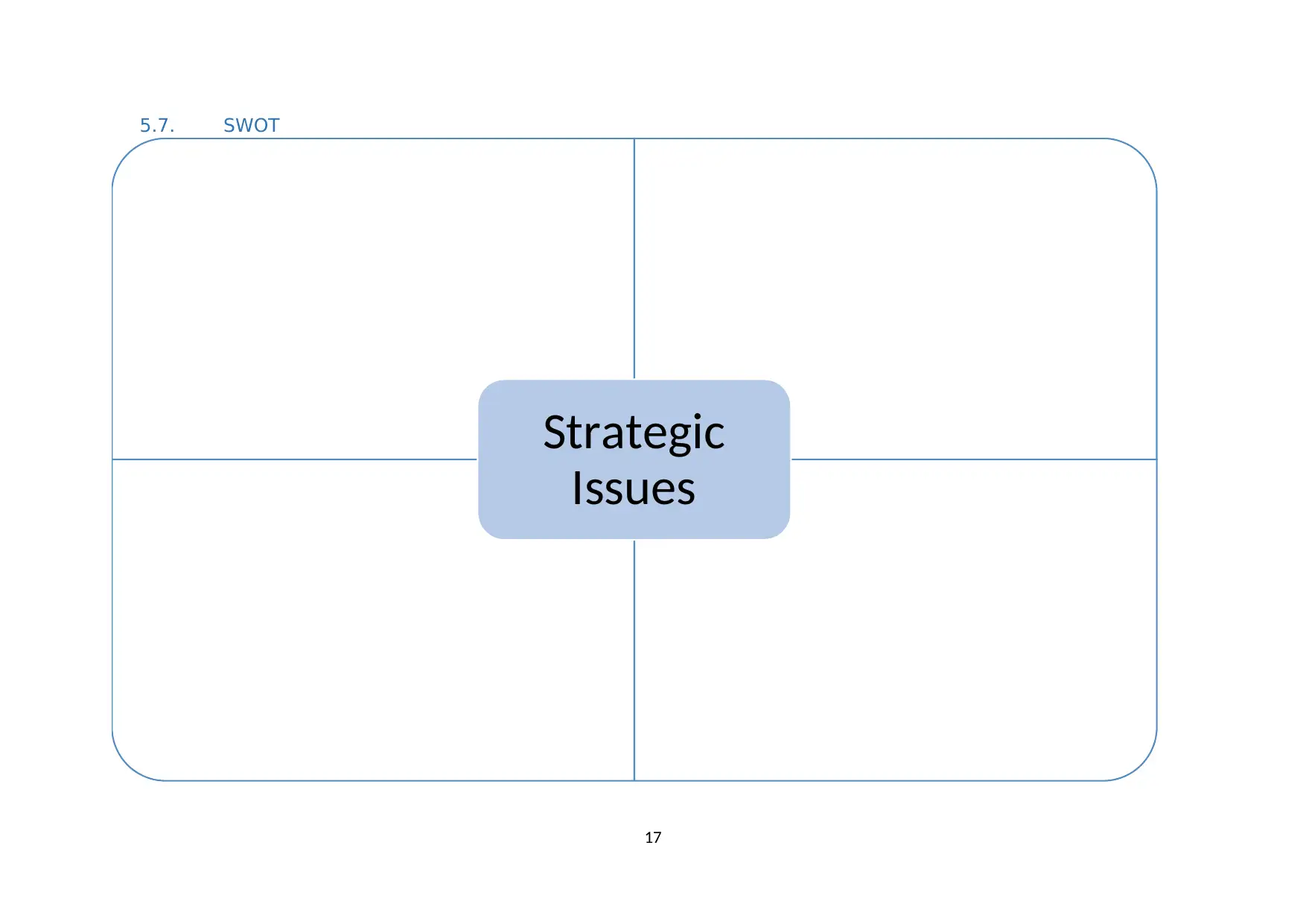
5.7. SWOT
17
Strengths
- Strong branding
- Social Media Presence
- Key company values
Opportunities
- Niche products
- Smaller company
Weaknesses
- Reliance on larger firm
- Reliance on Farms
- Higher price point
Threats
- Fonterra Dominance
- Availability of raw materials
Strategic
Issues
17
Strengths
- Strong branding
- Social Media Presence
- Key company values
Opportunities
- Niche products
- Smaller company
Weaknesses
- Reliance on larger firm
- Reliance on Farms
- Higher price point
Threats
- Fonterra Dominance
- Availability of raw materials
Strategic
Issues
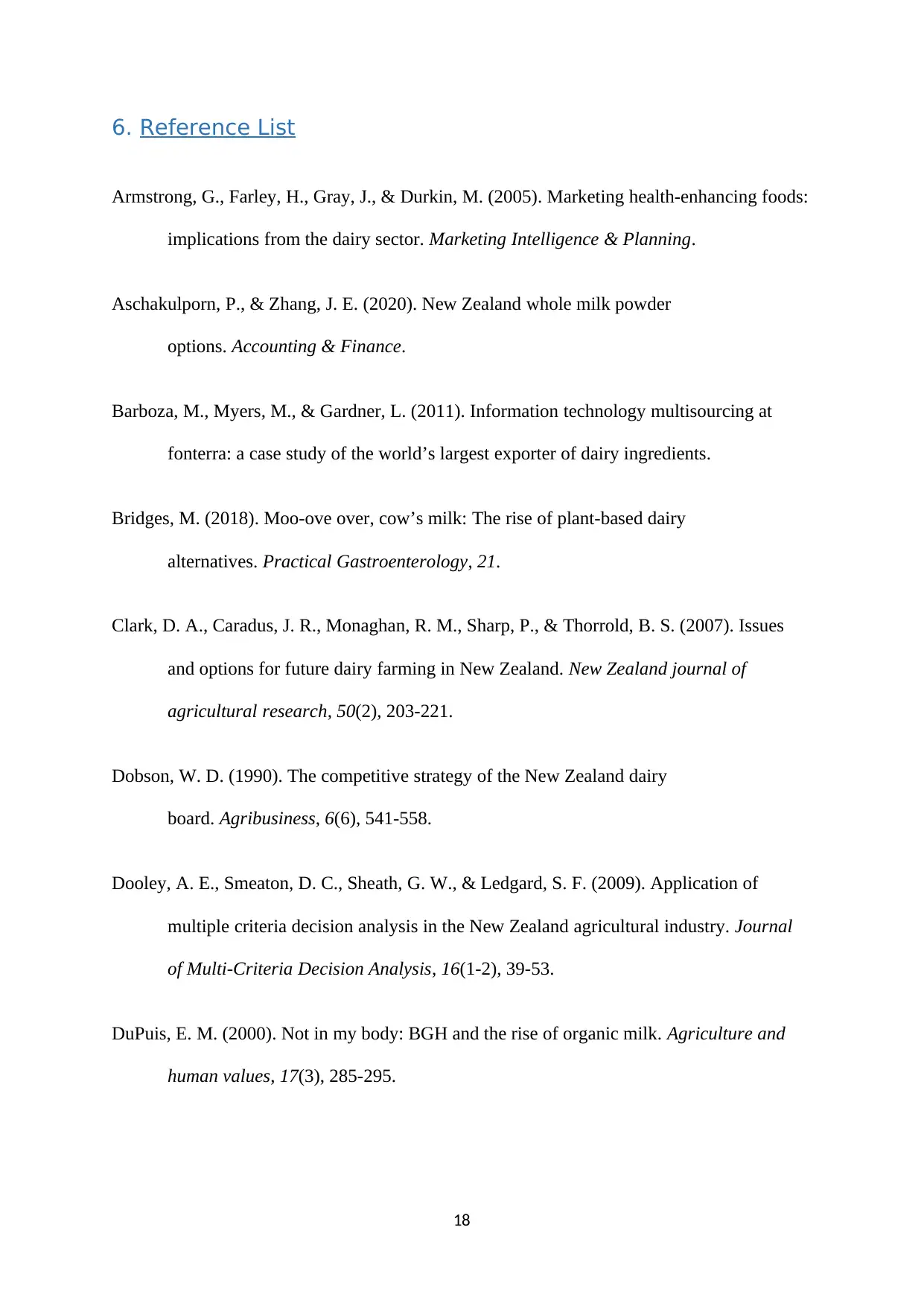
6. Reference List
Armstrong, G., Farley, H., Gray, J., & Durkin, M. (2005). Marketing health‐enhancing foods:
implications from the dairy sector. Marketing Intelligence & Planning.
Aschakulporn, P., & Zhang, J. E. (2020). New Zealand whole milk powder
options. Accounting & Finance.
Barboza, M., Myers, M., & Gardner, L. (2011). Information technology multisourcing at
fonterra: a case study of the world’s largest exporter of dairy ingredients.
Bridges, M. (2018). Moo-ove over, cow’s milk: The rise of plant-based dairy
alternatives. Practical Gastroenterology, 21.
Clark, D. A., Caradus, J. R., Monaghan, R. M., Sharp, P., & Thorrold, B. S. (2007). Issues
and options for future dairy farming in New Zealand. New Zealand journal of
agricultural research, 50(2), 203-221.
Dobson, W. D. (1990). The competitive strategy of the New Zealand dairy
board. Agribusiness, 6(6), 541-558.
Dooley, A. E., Smeaton, D. C., Sheath, G. W., & Ledgard, S. F. (2009). Application of
multiple criteria decision analysis in the New Zealand agricultural industry. Journal
of Multi‐Criteria Decision Analysis, 16(1‐2), 39-53.
DuPuis, E. M. (2000). Not in my body: BGH and the rise of organic milk. Agriculture and
human values, 17(3), 285-295.
18
Armstrong, G., Farley, H., Gray, J., & Durkin, M. (2005). Marketing health‐enhancing foods:
implications from the dairy sector. Marketing Intelligence & Planning.
Aschakulporn, P., & Zhang, J. E. (2020). New Zealand whole milk powder
options. Accounting & Finance.
Barboza, M., Myers, M., & Gardner, L. (2011). Information technology multisourcing at
fonterra: a case study of the world’s largest exporter of dairy ingredients.
Bridges, M. (2018). Moo-ove over, cow’s milk: The rise of plant-based dairy
alternatives. Practical Gastroenterology, 21.
Clark, D. A., Caradus, J. R., Monaghan, R. M., Sharp, P., & Thorrold, B. S. (2007). Issues
and options for future dairy farming in New Zealand. New Zealand journal of
agricultural research, 50(2), 203-221.
Dobson, W. D. (1990). The competitive strategy of the New Zealand dairy
board. Agribusiness, 6(6), 541-558.
Dooley, A. E., Smeaton, D. C., Sheath, G. W., & Ledgard, S. F. (2009). Application of
multiple criteria decision analysis in the New Zealand agricultural industry. Journal
of Multi‐Criteria Decision Analysis, 16(1‐2), 39-53.
DuPuis, E. M. (2000). Not in my body: BGH and the rise of organic milk. Agriculture and
human values, 17(3), 285-295.
18
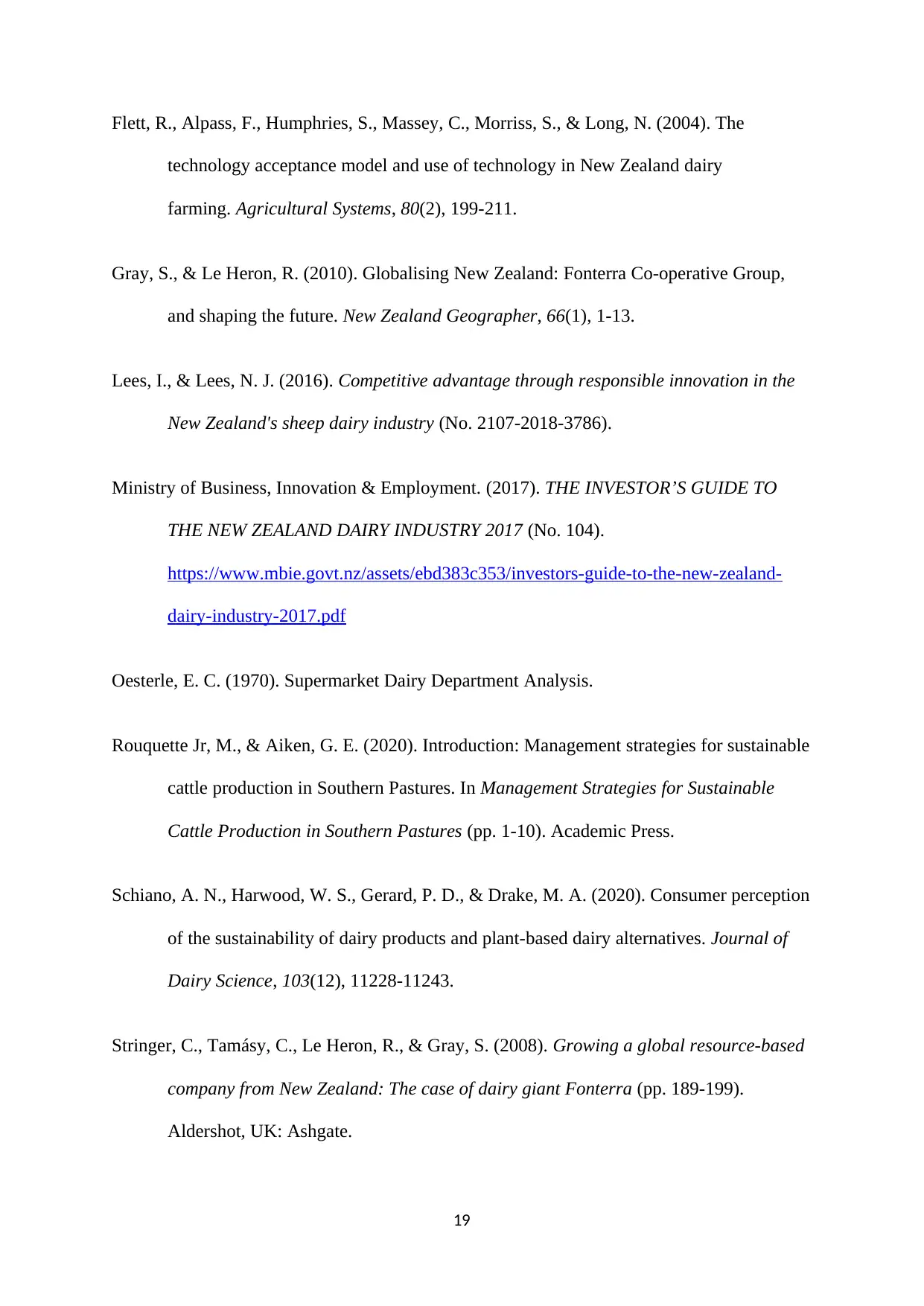
Flett, R., Alpass, F., Humphries, S., Massey, C., Morriss, S., & Long, N. (2004). The
technology acceptance model and use of technology in New Zealand dairy
farming. Agricultural Systems, 80(2), 199-211.
Gray, S., & Le Heron, R. (2010). Globalising New Zealand: Fonterra Co‐operative Group,
and shaping the future. New Zealand Geographer, 66(1), 1-13.
Lees, I., & Lees, N. J. (2016). Competitive advantage through responsible innovation in the
New Zealand's sheep dairy industry (No. 2107-2018-3786).
Ministry of Business, Innovation & Employment. (2017). THE INVESTOR’S GUIDE TO
THE NEW ZEALAND DAIRY INDUSTRY 2017 (No. 104).
https://www.mbie.govt.nz/assets/ebd383c353/investors-guide-to-the-new-zealand-
dairy-industry-2017.pdf
Oesterle, E. C. (1970). Supermarket Dairy Department Analysis.
Rouquette Jr, M., & Aiken, G. E. (2020). Introduction: Management strategies for sustainable
cattle production in Southern Pastures. In Management Strategies for Sustainable
Cattle Production in Southern Pastures (pp. 1-10). Academic Press.
Schiano, A. N., Harwood, W. S., Gerard, P. D., & Drake, M. A. (2020). Consumer perception
of the sustainability of dairy products and plant-based dairy alternatives. Journal of
Dairy Science, 103(12), 11228-11243.
Stringer, C., Tamásy, C., Le Heron, R., & Gray, S. (2008). Growing a global resource-based
company from New Zealand: The case of dairy giant Fonterra (pp. 189-199).
Aldershot, UK: Ashgate.
19
technology acceptance model and use of technology in New Zealand dairy
farming. Agricultural Systems, 80(2), 199-211.
Gray, S., & Le Heron, R. (2010). Globalising New Zealand: Fonterra Co‐operative Group,
and shaping the future. New Zealand Geographer, 66(1), 1-13.
Lees, I., & Lees, N. J. (2016). Competitive advantage through responsible innovation in the
New Zealand's sheep dairy industry (No. 2107-2018-3786).
Ministry of Business, Innovation & Employment. (2017). THE INVESTOR’S GUIDE TO
THE NEW ZEALAND DAIRY INDUSTRY 2017 (No. 104).
https://www.mbie.govt.nz/assets/ebd383c353/investors-guide-to-the-new-zealand-
dairy-industry-2017.pdf
Oesterle, E. C. (1970). Supermarket Dairy Department Analysis.
Rouquette Jr, M., & Aiken, G. E. (2020). Introduction: Management strategies for sustainable
cattle production in Southern Pastures. In Management Strategies for Sustainable
Cattle Production in Southern Pastures (pp. 1-10). Academic Press.
Schiano, A. N., Harwood, W. S., Gerard, P. D., & Drake, M. A. (2020). Consumer perception
of the sustainability of dairy products and plant-based dairy alternatives. Journal of
Dairy Science, 103(12), 11228-11243.
Stringer, C., Tamásy, C., Le Heron, R., & Gray, S. (2008). Growing a global resource-based
company from New Zealand: The case of dairy giant Fonterra (pp. 189-199).
Aldershot, UK: Ashgate.
19
Paraphrase This Document
Need a fresh take? Get an instant paraphrase of this document with our AI Paraphraser
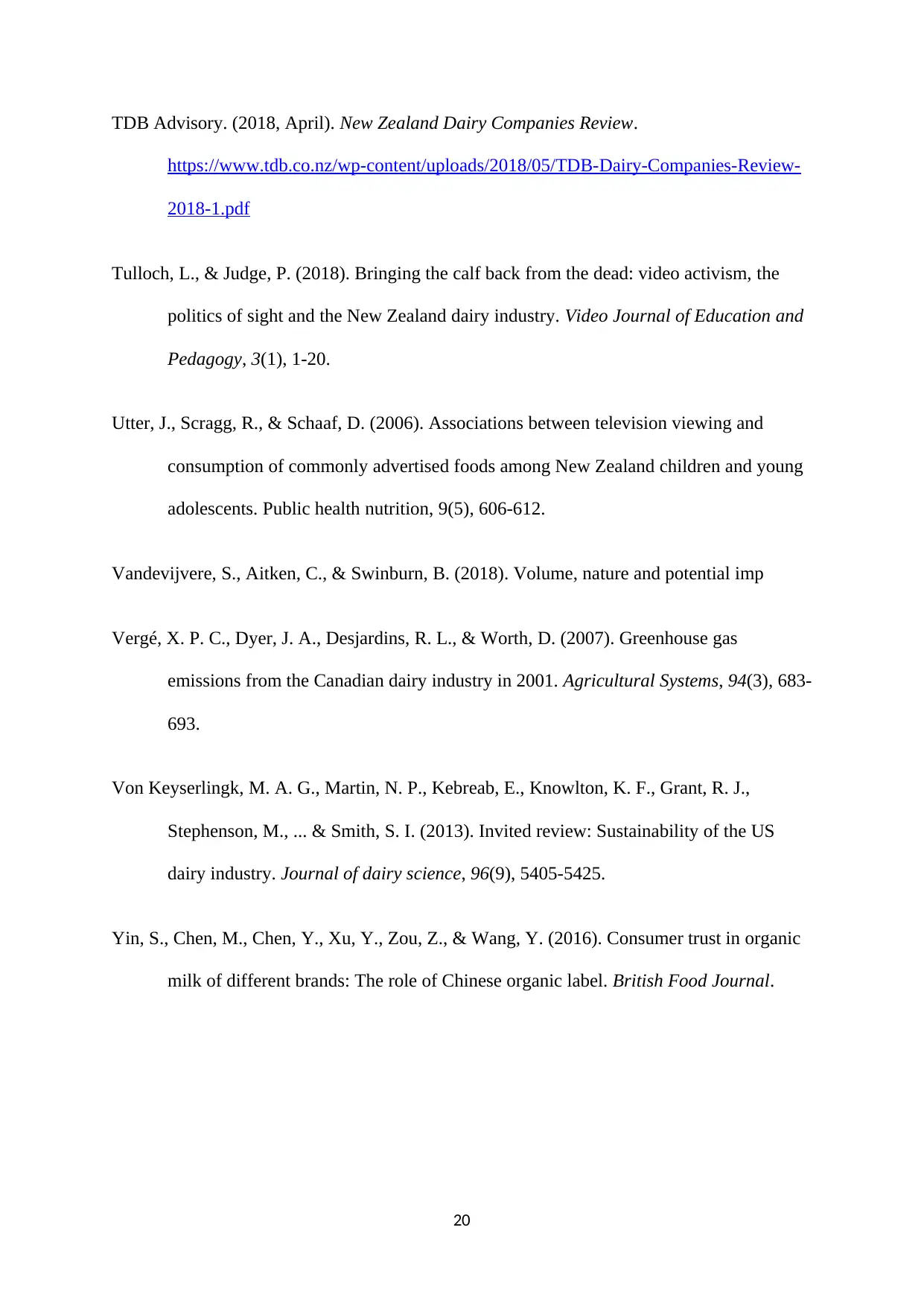
TDB Advisory. (2018, April). New Zealand Dairy Companies Review.
https://www.tdb.co.nz/wp-content/uploads/2018/05/TDB-Dairy-Companies-Review-
2018-1.pdf
Tulloch, L., & Judge, P. (2018). Bringing the calf back from the dead: video activism, the
politics of sight and the New Zealand dairy industry. Video Journal of Education and
Pedagogy, 3(1), 1-20.
Utter, J., Scragg, R., & Schaaf, D. (2006). Associations between television viewing and
consumption of commonly advertised foods among New Zealand children and young
adolescents. Public health nutrition, 9(5), 606-612.
Vandevijvere, S., Aitken, C., & Swinburn, B. (2018). Volume, nature and potential imp
Vergé, X. P. C., Dyer, J. A., Desjardins, R. L., & Worth, D. (2007). Greenhouse gas
emissions from the Canadian dairy industry in 2001. Agricultural Systems, 94(3), 683-
693.
Von Keyserlingk, M. A. G., Martin, N. P., Kebreab, E., Knowlton, K. F., Grant, R. J.,
Stephenson, M., ... & Smith, S. I. (2013). Invited review: Sustainability of the US
dairy industry. Journal of dairy science, 96(9), 5405-5425.
Yin, S., Chen, M., Chen, Y., Xu, Y., Zou, Z., & Wang, Y. (2016). Consumer trust in organic
milk of different brands: The role of Chinese organic label. British Food Journal.
20
https://www.tdb.co.nz/wp-content/uploads/2018/05/TDB-Dairy-Companies-Review-
2018-1.pdf
Tulloch, L., & Judge, P. (2018). Bringing the calf back from the dead: video activism, the
politics of sight and the New Zealand dairy industry. Video Journal of Education and
Pedagogy, 3(1), 1-20.
Utter, J., Scragg, R., & Schaaf, D. (2006). Associations between television viewing and
consumption of commonly advertised foods among New Zealand children and young
adolescents. Public health nutrition, 9(5), 606-612.
Vandevijvere, S., Aitken, C., & Swinburn, B. (2018). Volume, nature and potential imp
Vergé, X. P. C., Dyer, J. A., Desjardins, R. L., & Worth, D. (2007). Greenhouse gas
emissions from the Canadian dairy industry in 2001. Agricultural Systems, 94(3), 683-
693.
Von Keyserlingk, M. A. G., Martin, N. P., Kebreab, E., Knowlton, K. F., Grant, R. J.,
Stephenson, M., ... & Smith, S. I. (2013). Invited review: Sustainability of the US
dairy industry. Journal of dairy science, 96(9), 5405-5425.
Yin, S., Chen, M., Chen, Y., Xu, Y., Zou, Z., & Wang, Y. (2016). Consumer trust in organic
milk of different brands: The role of Chinese organic label. British Food Journal.
20
1 out of 20
Related Documents
Your All-in-One AI-Powered Toolkit for Academic Success.
+13062052269
info@desklib.com
Available 24*7 on WhatsApp / Email
![[object Object]](/_next/static/media/star-bottom.7253800d.svg)
Unlock your academic potential
© 2024 | Zucol Services PVT LTD | All rights reserved.





